Chill: Adventures Into the Unknown by Halloween Jack
Introduction
Original SA post
I don't know why, but I decided to do this one next:
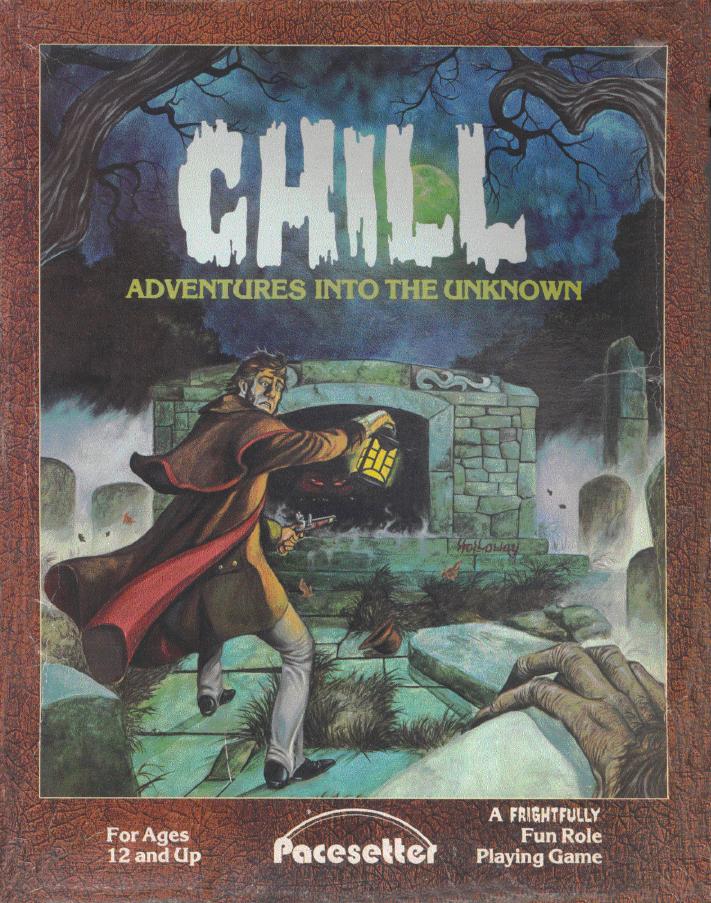
Chill is a horror roleplaying game wherein the PCs are members of SAVE, a secret international society of monster-hunting. As opposed to Call of Cthulhu's sanity-blasting cosmicism, Chill is geared more toward Hammer Horror, Kolchak the Night Stalker type scenarios where the PCs can fight the supernatural and win--but not if they go in with all guns blazing. The first edition, published by Pacesetter, is said to be lighter and pulpier in tone. Eventually the game line was sold to Mayfair Games, who released a new 2nd edition rulebook and a line of supplements with a decidedly more visceral tone:
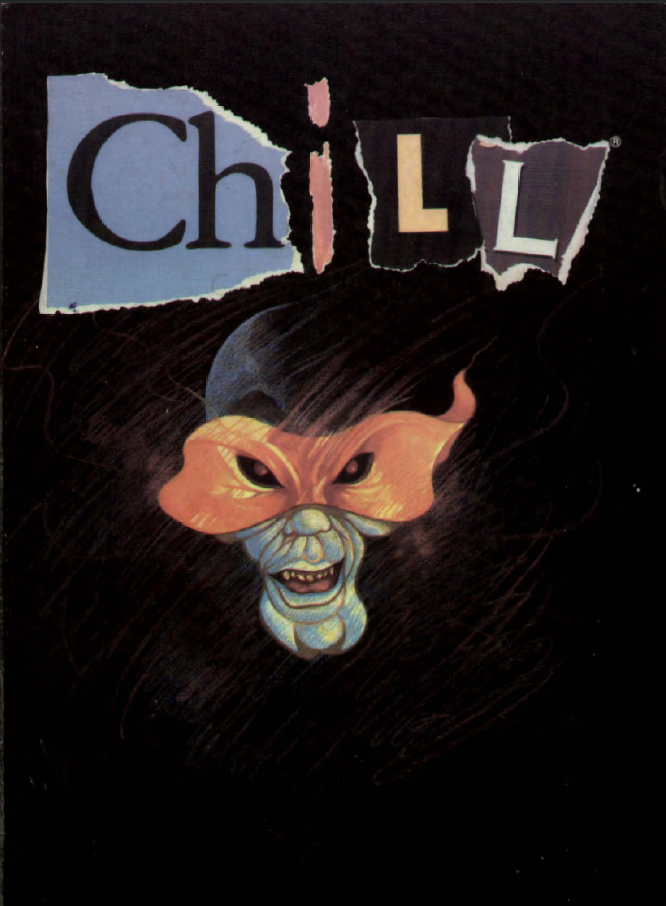
A company called Other World Creations (OWC) bought the rights and planned to release a 3rd edition, but it never got beyond a 45-page quick-start PDF.Notably, it was (or would have been) designed by Jess Heinig and John Wick. Chill 3rd Ed. became vapourware when OWC delayed the game, saying that they were trying to earn the cash to fund Chill by publishing third-party supplements for Call of Cthulhu. When that didn't work out, they created a Fundable (remember Fundable?) that failed miserably, and now the "official" webpage for Chill leads to domain-name squatters.
Sadly, Chill is probably outmoded by modern standards--if you want to send brave-but-not-superheroic protagonists against traditional horror antagonists, there are a number of games to suit your needs depending on your choice of system--Hunter: the Vigil, Dresden Files, Supernatural, and a number of versions of Savage Worlds and Gumshoe. Still, it bugs me that a game could apparently be well-liked enough to get a number of supplements across two editions and then be forgotten, so I'm doing this. Assuming my interest holds out, this will be the first time I review an entire game line, including all the supplements for both editions.
1e Box Set
Original SA post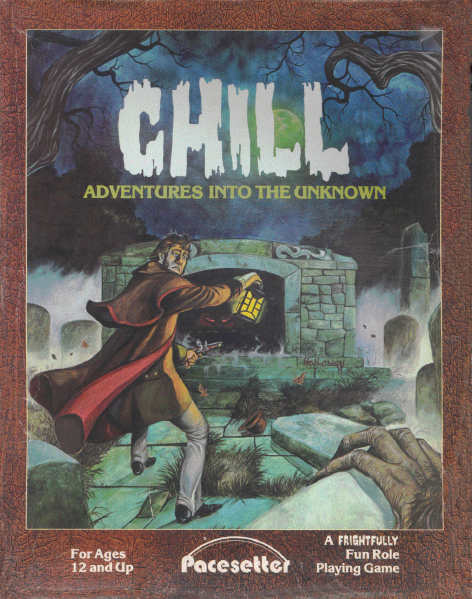
Mina! I've soiled my stirrup pants!
CHILL: Adventures into the Unknown
CHILL's first edition was sold as a boxed set. It contains the following:
--An 8-page introductory folder which explains the concept of a RPG, summarizes the rules, and has 4 pages of introductory characters.
--An introductory scenario called "Terror in Warwick House."
--The "campaign book," which is a funny thing to call a player's guide.
--The "Horrors from the Unknown" monster book
--A map. One side is of the setting (which is weird because CHILL is just modern-day-plus-monsters) and the other is of the Warwick House.
--Counters! One-hundred and forty cardboard counters of everything from PCs and monsters to vehicles and furniture. I have a feeling you don't actually need any of these to play a game of CHILL.
---Three free ten-siders.
Thankfully, the intro folder only spends three paragraphs explaining What Is An RPG before listing the contents of the box. After that, it explains the role of GM. Well, in fact, the referee in a CHILL game is called the CHILL Master , or CM. The book notes that the CM is probably going to be the guy who bought the game, and the CM--
wait

Oh, dear.

There's no getting out of this. You have to put up with me for 26 books.
CHILL characters are members of a secret society called the Societas Albae Viae Eternitata, or "Eternal Society of the White Way." (Ouch. I promise this isn't RaHoWa.) Of course, it's always just called SAVE or "the Society." SAVE's members know the secret truth about the world: creatures like vampires, ghouls, ghosts, and werewolves exist, and they come from a mysterious dimension which SAVE simply calls "The Unknown." SAVE's mission is to learn everything it can about the Unknown, and stop its denizens from wreaking havoc when they enter our world. SAVE's "White Way" is opposed to the Unknown's "Evil Way," which is what they call the creatures' supernatural powers.
CHILL suggests you let players pick the pregenerated characters they want to play, but first it explains the basics of the rules. Characters have 8 Basic Abilities: Strength, Dexterity, Agility, Personality, Perception, Willpower, Luck, and Stamina. These scores run from 26-80. Skill scores run from 41-135, and we won't know the relationship between basic ability scores and skills until we get into the formal rules. Every character also has two derived stats. The first is Unskilled Melee, which is what you use when you don't have a relevant combat skill, but you need to punch a zombie or hit it with a cricket bat. The second is the self-explanatory Sensing Unknown; it's your chance to detect that a monster is nearby.
CHILL's a percentile die system; I assume you all know how that works. We're told that sometimes we'll be rolling 2d10 or 3d10--mainly for damage effects, I'm thinking. There are two kinds of skill checks:
General Check : Try to roll under your relevant Basic Ability or Skill on a d100. If you do, you succeed. Like I said, a percentile system.
Specific Check : For specific checks, if you succeed, you subtract what you rolled from your total Ability/Skill and check the margin on the CHILL TM Action Table to determine how well you performed.
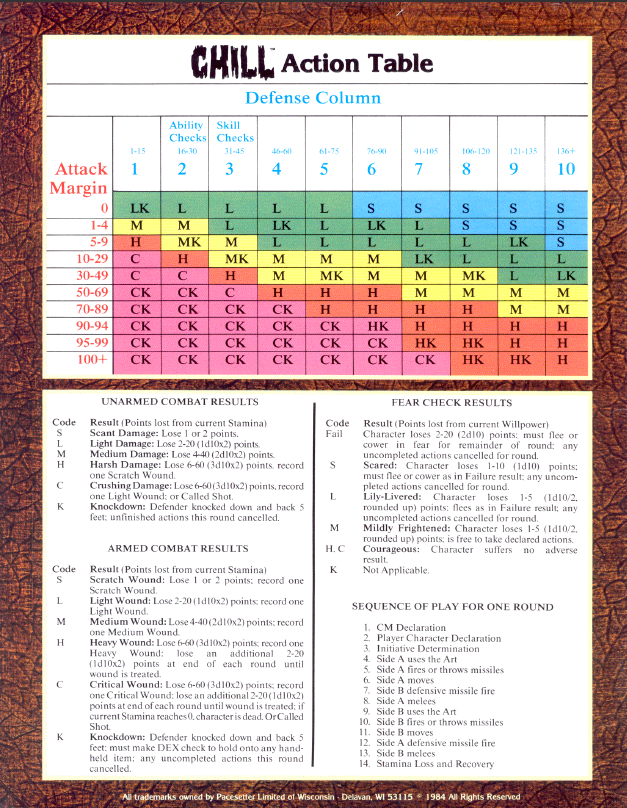
As you can see, it’s mostly important for combat, namely attack rolls and monster-induced fear checks.
The boxed set’s instructions insist that you play through the intro scenario before reading the rules proper, and who am I to argue? Submitted for your approval, the cast of “Terror at Warwick House.”
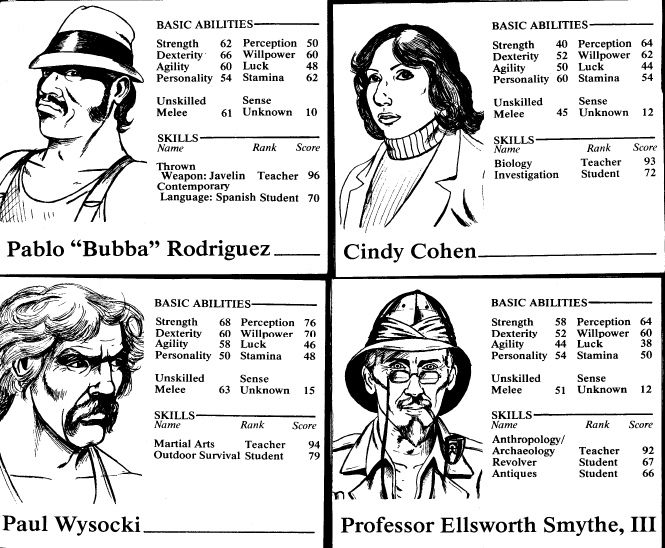
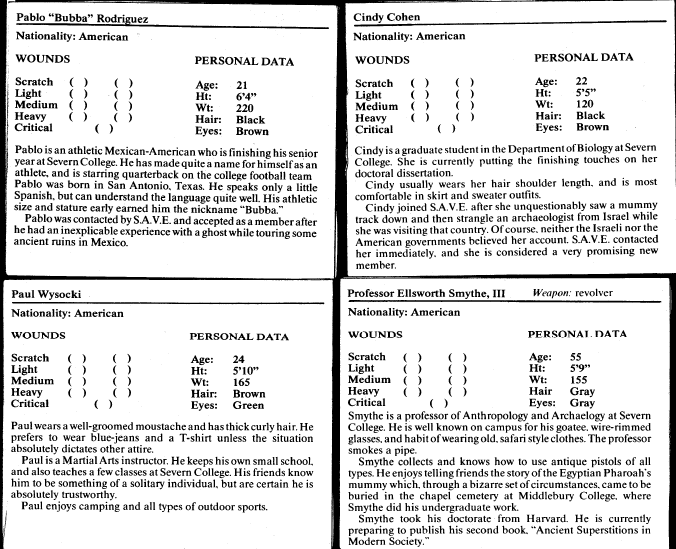
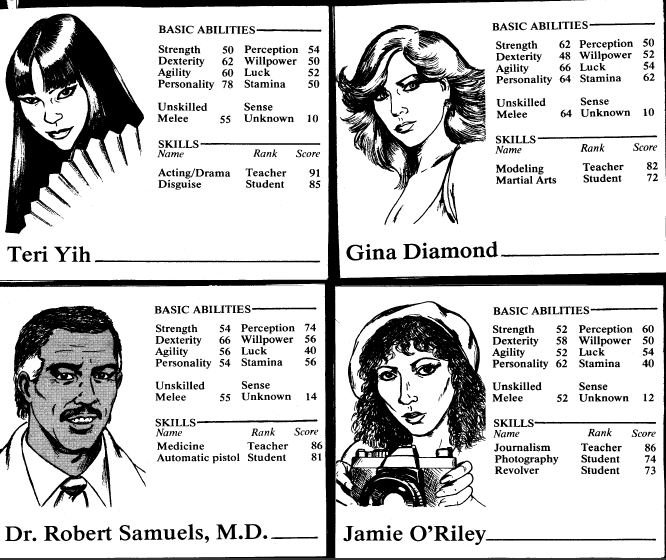
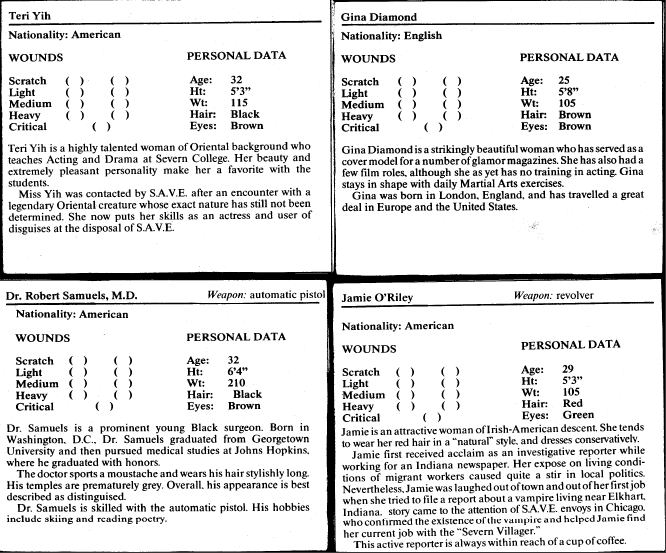

Well, what do we have here? The nicest guy on OKCupid, a turtleface, two guys who go “antiquing” and take “camping trips” together, Charlie’s Angels, Dr. Pedostache, and a trigger-happy paparazzi.
Next time, on CHILL : “Terror at Warwick House.”
Terror in Warwick House
Original SA post
CHILL: Adventures into the Unknown, Part II: "Terror in Warwick House"
"Terror in Warwick House" is the introductory adventure designed to guide the CHILL Master and the players through their first scenario. If I'm not mistaken, they recommend you do this before reading any more of the rules.
What's striking about this scenario, and the reason I've procrastinated this update so long, is that it's very heavily mapped, and I don't normally fool with such things. The tiny index-card character sheets, allotted equipment, and tile map of the whole mansion make this feel like early-edition Arkham Horror rather than a roleplaying game.
The adventure is very Choose-Your-Own-Adventurish, with every room in the house keyed, and each room description containing exact text to read aloud to your players. I guess if you're 12 and roleplaying for the first time, this is as good a hand-holding as you can ask for. (There's a note that if none of the players comes with a weapon, give a revolver to the one with the highest Dexterity.) The game takes great pains to explain how CHILL is not a board game and follows basic common sense. "For example, if characters fight and destroy a zombie in the kitchen, the destroyed zombie will not attack them again when they return to the kitchen. Still the room will show signs of the fight."
What you tell the players
The adventure centers on Dr. Smythe (one of the pregen characters) who's asked the other characters to help investigate Warwick House, an colonial-era house owned by Severn College in Massachusetts. The college has tried to have the house demolished several, but the workers always quit after losing men to mysterious deaths before any work could be done. The house was built in 1768 by John and Sarah Warwick. They were generally spiteful, hateful, and cruel, and were eventually murdered in their own house during the American Revolution--John Warwick tricked the British soldiers occupying the town into ambushing a meeting of "rebels" that was merely a town hall meeting including women and children. The Warwicks were hung in their own house. People in Severn believe the Warwick house is haunted, sometimes seeing strange lights through the windows. The last attempt to demolish the house was just a few weeks ago; two workers died setting up equipment around the property.
What you don't tell the players
The Warwicks were already ghosts when the townsfolk killed them in 1777! No, wait, bear with me here. In the 1600s, Warwick was an English criminal who wanted to emigrate to Massachusetts. Somehow, he was notorious enough for the governor of Massachusetts to know about him, but not in prison, and he was denied passage. He'd already paid a captain, who kept his money, and Warwick retaliated by murdering him. Warwick and his equally vicious wife were hanged, but their ghosts manifested on the ship. They used their ghostly ghost powers to cause it to wreck off the coast of Massachusetts, and used the timber to build Warwick House. When the colonists hung them in 1777, they decided to stick to being incorporeal spirits. Their only goals are to protect the house and to "avenge themselves on all mankind." The central beam of the attic is from the ship, and hanging from it are two nooses to remind them that they hate everybody. The players will have to destroy both in order to get 100% on the scenario.
Apparently, ghosts in CHILL can walk about functioning more-or-less as normal people, and build houses and show up in a colonial village and say "Hi, we just showed up out of nowhere and I'm going to build a house with wood from the shipwreck which only we survived." That's interesting.
On to the adventure. I'll just do this room by room
Outside Warwick House: The PCs are outside a three-story house with boarded-up windows. CHILL gets really board-gamey again as it says you can let PCs move up to five squares around the outside, but not to let two minis occupy the same square. It also says not to let some PCs remain outside while others go in--which is all well and good, since there's nothing outside the house.
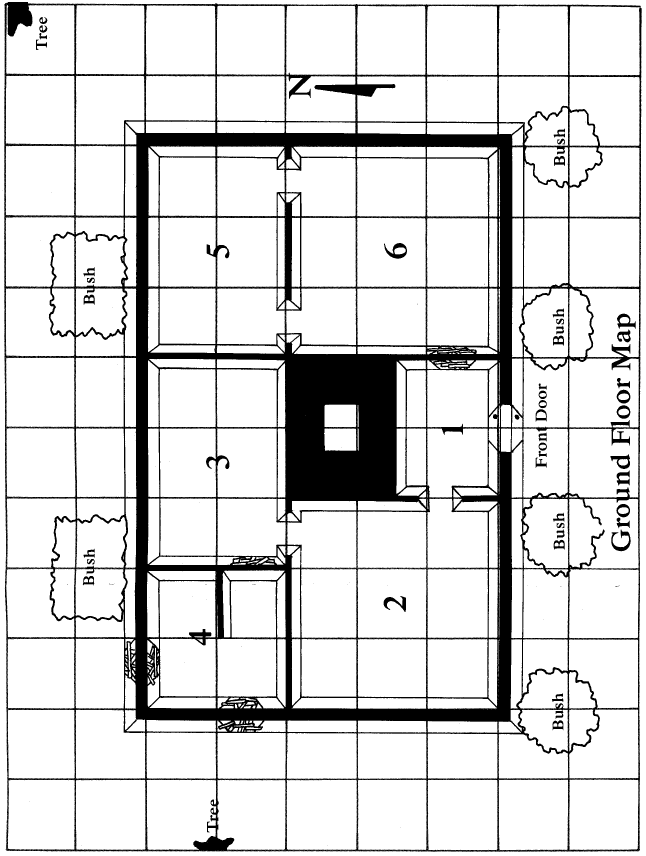
Encounter 1, The Vestibule : The PCs see a dangling noose, hanging in midair! If they pass a Sense Unknown check, they find that the whole house is full of evil power and a creature of the Unknown probably waits through the door to their left. The noose is actually held up by the invisible ghost of John Warwick. Further attempts to Sense the Unknown are useless, since the whole house is suffused with it. There are stairs leading upward, but the CM is instructed to not allow the players to go up--it doesn’t even suggest how to prevent it.
Encounter 2, The Hall : The vestibule leads into a dusty hall--not a hallway, but like a living room, with a fireplace, chair, and an unlocked chest. The CM calls for a Perception check; success reveals footprints leading through the door to the north. If the PCs open the chest, they find it contains nothing but a portrait of John Warwick. This prompts the ghost to use one of his Evil Way powers, Throw Voice, to make peals of insane laughter issue from the painting. All the players must make a Fear check, which is the CM's introduction to using the Action Table--if a PC fails, the table takes the margin of failure and uses it to determine how much Willpower they lose. They're also forced to flee the house, which means nothing in a bounded scenario like this--they'll just be embarrassed and have to walk back in to sheepishly confront the other investigators. (Oh, and the CM gives the PCs "the most evil laugh you can manage." It says so.)
The CM is supposed to ask the PCs if they want to examine the portrait or go through the north door. The portrait depicts a man in 18th century dress, in a pose of crazed, almost evil laughter.

Ahem. There's nothing else special about the painting. If the PCs decide to destroy it, sure, it's just a painting. After that, there's nothing else for them to do but go through the north door.
Encounter 3, The Kitchen : A young man, dressed like it's the 1920s, lies on the table. The footprints lead up to it. There are doors to the east and west, and another, boarded-up door to the west.
If the PCs examine the body, they can’t tell if he’s alive or dead without touching him. If they touch him, whoops--he’s a zombie! Warwick’s ghost was using an Evil Way discipline to make the decades-decayed body appear fresh; when they touch him, the illusion drops. The characters must make a fear check, those who don’t run away have to make a surprise check, and in any case, the zombie tries to strangle the nearest PC as soon as possible. A critical (“CK”) result on the attack chart forces the victim to pass a Stamina check or be choked unconscious; a good (“K”) result leaves them on the ground, pinned by the zombie.
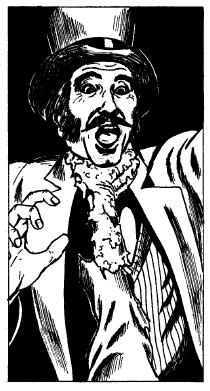
I say, old chap, wearing a rotten arm as a necktie makes me positively cross-eyed.
The players can attack the zombie if they aren’t running away, surprised, or busy being murdered. At least one character has a revolver, and guns are apparently pretty badass in these rules. If you actually have the revolver skill, you can fire 3 times per round. The revolver does 3d10*2 points of damage, and the zombie has 75 Stamina. The CM’s supposed to ask the players where they’re aiming, and a C or CK result means you hit your called shot--any successful shot to the head immediately kills the zombie.
The only catch is that because the zombie’s so close to a PC, any successful hit that isn’t a C or CK result has a 50/50 chance of hitting your friend. Oops. The module helpfully explains the rules for what happens if an accidental attack causes “Wounds” in addition to Stamina loss, but zombies aren’t affected by Wounds. The CM’s supposed to give the players the option of adjourning the adventure for the night and returning later, with all their Stamina and Willpower restored--however, they’ll face two zombies in the kitchen.
One of the doors leads to a pantry ( Encounter 4 ) that contains nothing, except that the angle of the ceiling shows that you’re under a stairway. The other door leads to the library.
Encounter 5, The Library : The library is shelved with crumbling books. Like every other room in this adventure, there is only one interesting thing: A table with a book and a letter. The diary is Sarah Warwick’s. The adventure instructs the CM how to tease out the process of asking the players if they’re going to examine the table, which they’re definitely going to do because there’s nothing else. The dusty footprints lead up to the table, and show signs of a struggle.
The letter reveals that Warwick was denied passage to America, and that he was put on trial for murder afterward, though it doesn’t confirm that he was executed in England. In the diary, Sarah admits to being John’s accomplice. The CM is supposed to cut these out of the book with scissors and hand them to the players. (He’s also supposed to give the players the opportunity to chicken out of the adventure at this point, which just leads to “Okay, the adventure’s over and you never solve the mystery. I have no idea why.)
Encounter 6, The Parlor : The only other doors in the library lead into the parlor, which is dusty and stocked with a fireplace, sofa, end tables, chairs, and a large table with a wooden chest on it. A boarded-up door leads back to the kitchen.
Now the CM is supposed to ask the players if they want to investigate, or retrace their steps and go upstairs. If they stay, they realize that an invisible force is writing on the ceiling in blood which drips onto the floor. If they don’t run off, it will eventually read “LEAVE NOW OR DIE.” The letters slowly drip off, and the pooled blood vanishes.
The CM is, again, supposed to give the players the option to chicken out of the adventure. If they act like proper adventurers and make a beeline for the chest, joke’s on them. There’s nothing to it.
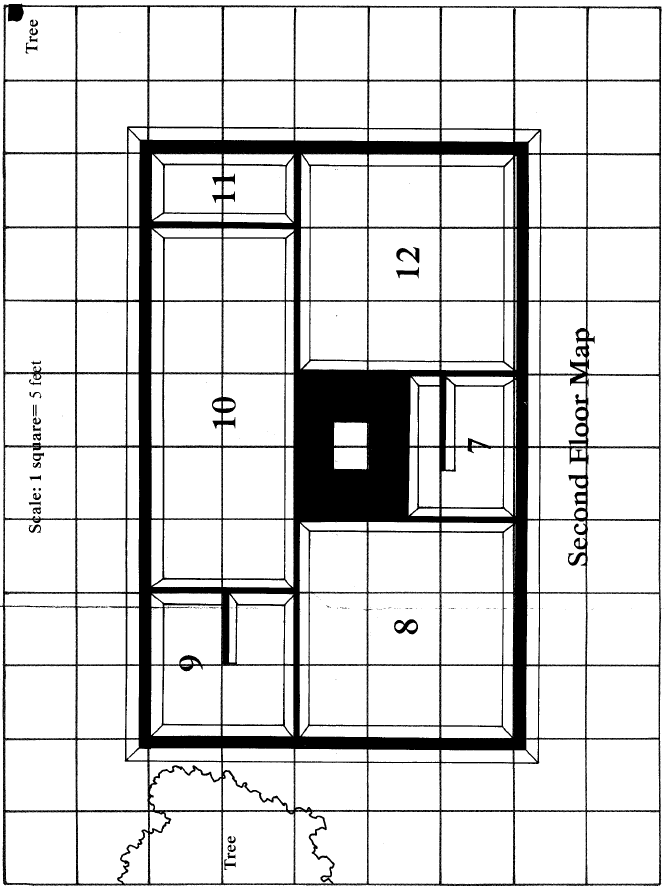
Encounter 7, The 2nd Floor Landing : The first player up the steps will have a hand emerge from the step and grab ahold of their leg if they fail a Perception check. If they’re caught, no harm is done, but it takes a full minute to pull their leg out. (Sarah Warwick’s ghost is using an Evil Way power called Gnarl to warp the wood. Stuff like this is sort of an introduction to the CM for how to use these powers.)
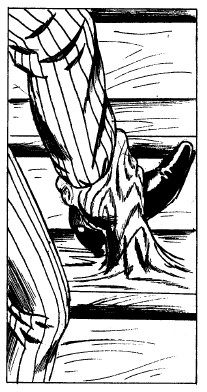
Thank you, Thing.
There are two doors at the top of the stairs, but one is boarded up and impassable.
Encounter 8, The West Bedroom : Before the players enter, a ghostly ball of light emerges from the room and flickers along the wall. This is another harmless use of an Evil Way power. The bedroom contains an empty fireplace and a dilapidated bed; if the players search, you’re advised to bluff the players by rolling dice behind your GM screen and telling them there’s nothing to find.
Encounter 9, The Backstairs Landing : The only door through the bedroom leads to a stale, dusty backstairs landing that goes down to the boarded-up door in the kitchen. The only way forward is through a door to the west.
(This is starting to read like Your Dungeon Is Suck’s parody of Dwimmermount, where there are dozens of rooms that contain nothing but dust and the occasional used condom.)
Encounter 10, The North Room : This room contains an empty fireplace, a table piled with random junk, a heap of tools and wooden pegs in the corner, and a door to the south.
If the players search the table, they’ll find the captain’s log of the ship Mercy, and another diary of Sarah Warwick’s, from the year they were hung in New England. There’s also a weathered board with the word “Mercy” carved into it.
The captain’s log states that the crew have been seeing ghostly lights that flickered about and took human form, and later goes on to say that he’s begun seeing them, a crewman went mad and fell overboard, and that he fears the storm that’s been brewing.
Sarah’s diary makes it quite clear that it’s written by a ghost--they thought they were doing England a favour by tricking the British Captain into massacring civilians, she says that they built their house from the timber of the Mercy, and that now that they’ve been “killed” again, they’ll dwell forever in the house in corporeal form. She also hands out the solution to the adventure by writing that the beam of the house is the keel of the Mercy, and “the heart of the House.”
If they examine the tools, they can take an axe, hammer, and saw. If any character passes a passive Perception check, they realize that the room is about five feet too short--studying the wall reveals a secret door leading to an attic staircase! They can go up the stairs ( Encounter 11 ), or through the southern door.
Encounter 12, The East Bedroom : It’s another dusty room with two small beds, another empty fireplace, more empty chests, and another prompt to ask the players if they want to quit the adventure.
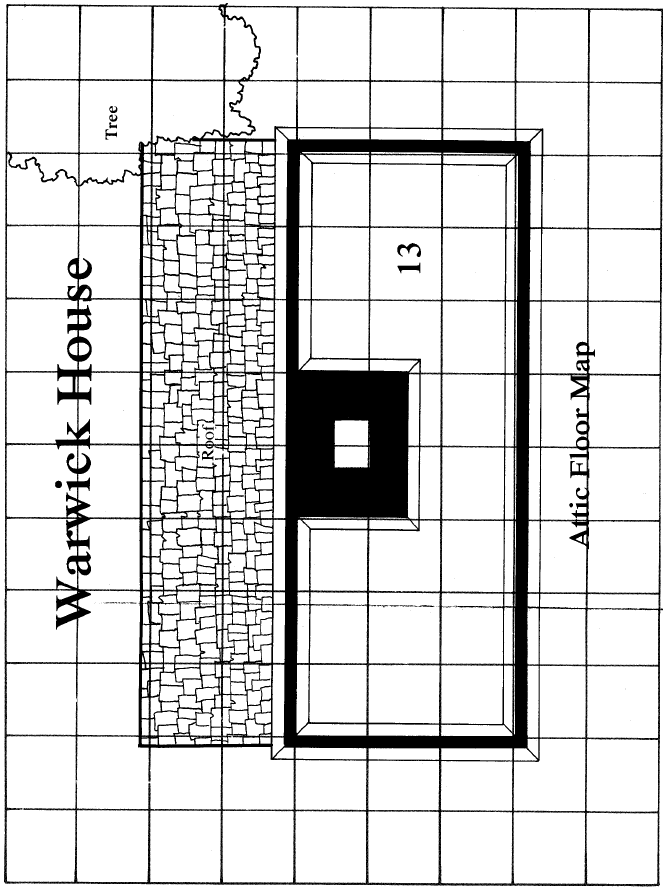
Encounter 13, Meet John and Sarah : When the players enter the attic, they immediately notice the huge beam that runs the length of the room, is not part of the building itself, and has two nooses dangling from it. Then they see two pale blue lights coalescing into human form, and a voice saying “Good evening. We’ve been expecting you.”
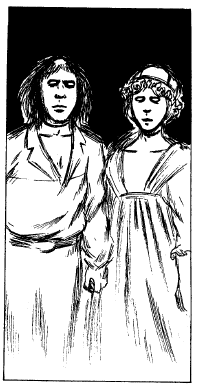
Marc Bolan really let himself go before the end.
If the PCs do the smart thing and start destroying the beam, the ghosts wail in agony and disperse when the beam is cut in two. They also need to cut down the nooses to destroy the ghosts permanently. It only takes a round to cut the old dry wood, but if they give the Warwicks a chance, they manifest as a ghostly man and woman in Colonial-era clothes that look worn and frayed, hovering above the floor with their feet dangling.
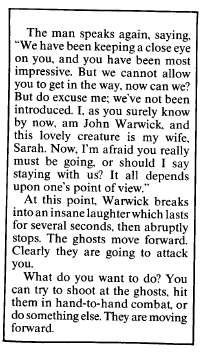
If the PCs don’t declare “destroy the beam” as their first action, they have to make Fear checks and combat begins. All attacks directed at the Warwicks are useless. The Warwicks attack with a power called Chilling Touch. John has a 135% chance to hit; Sarah’s is only 85% because she’s a girl . The chilling touch does damage, and stuns the victim for a round.
If the players never think to destroy the timber, sucks to be them; combat continues until they’re all knocked out (running away isn’t considered). If they destroy the timber but not the nooses, the Warwicks fade away, and the CM is supposed to ask them if there’s anything else they want to do before leaving the house--if not, the adventure ends with Dr. Smythe informing them that another attempt to demolish the Warwick House has failed. If they do destroy the nooses, the ghosts crumble into dust and the CM congratulates them on a job well done.
For destroying the ghosts and the zombie, the characters get a total of 2,390 Insight points (experience) split among them. You are now allowed to put away this stupid adventure and actually read the actual CHILL rulebook.
So that’s the introduction to CHILL. It’s a really railroady adventure that definitely doesn’t need tokens or a map, contains a lot of areas where there’s nothing interesting to do, tracks "Encounters" where the PCs don't encounter anything, and only has one possible solution (that’s kind of weird). Two thumbs down.
Next time, on CHILL : We put away this stupid adventure and actually read the actual CHILL rulebook.
Campaign Book, part 1
Original SA post
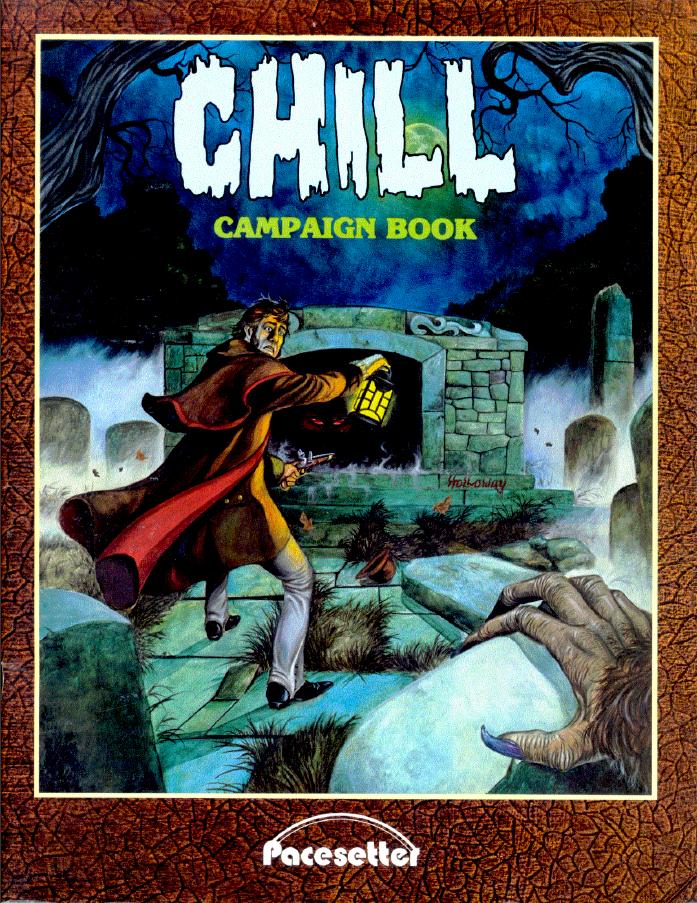
Between a monster on a rock and a monster in a fireplace.
CHILL: Adventures into the Unknown: Campaign Book, Part 1
The campaign book opens with a single page of fiction--a monster hunter named Lord Boulton, has tracked a monster (referred to only as IT! and the THING!) to a remote cemetery. He trips over a tombstone, discharging his flintlock pistol, and realizes too late that the monster has lured him to a place it controls, where no one can help him. His ghostly enemy coalesces as its zombie minion strangles the life out of him. (CHILL is hung up on ghosts controlling zombie minions, it seems.)
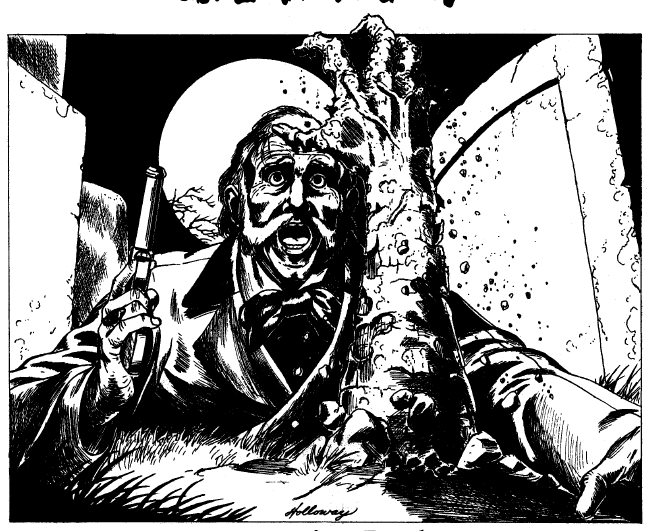
This can't happen to me. Can you see this moustache?
The book’s introduction is given by “Raven,” apparently an evil bird who will guide us through the rules in a conversational tone, make wry jokes, and say “Heh, heh” a lot. I’m sure this won’t become an annoying framing device.

No, not that guy. This thing.
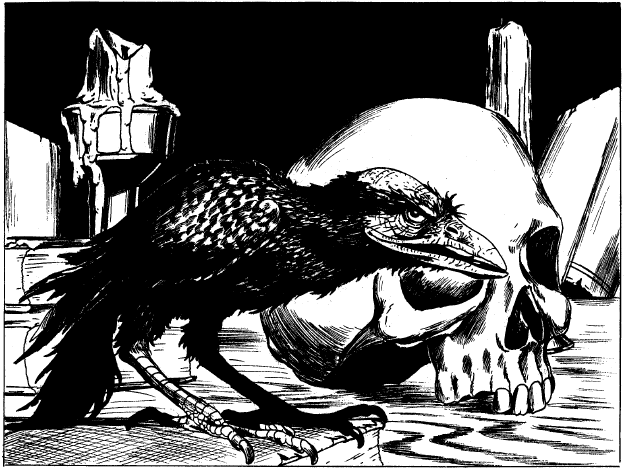
I plucked my head for cancer awareness.

Raven sucks. I’m the best in the world.
Ahem. The intro chapter gives a basic explanation of roleplaying, and tells us that CHILL characters are envoys of SAVE, an organization that investigates and combats supernatural threats to humanity which come a parallel dimension called “The Unknown.” SAVE can provide characters with information and equipment, but you can’t rely on the organization to save your bacon when you blunder into danger.
We’re reminded of how general checks (roll under your ability score) work, and specific checks--roll under your ability score, take the difference, and consult the Action Table--for more specific results which mainly pertain to combat.
CHILL Campaign Book, Part 2: Character Creation
CHILL characters have eight attributes: Strength, Dexterity, Agility, Personality, Perception, Stamina, and Luck.
CHILL only uses random rolls for generating ability scores. Roll 3d10, add them together, double that, and add 20. Got it? Good. A little weird, but it’s weighted towards a strong average. You do this eight times, and assign them to the abilities as you choose. This gives you a range from 26 to 80. CHILL says the average score for a normal person is 50.
There’s one derived stat, “Unskilled Melee,” which is the average of your Strength and Agility. The number of skills you get is also random; a d10 roll gives you from 2 to 5 skill points. If you have Perception >60 and Willpower >50, you get to choose an Art (magic) discipline as described in Chapter 6.
There’s a chart for suggested height and weight, and some “duh” notes that your skills should make sense in terms of your character background. More notable is that CHILL outright says that it assumes characters have a job or inheritance that supports them but that also allows enough free time for them to go adventuring, and that they are assumed to have the status to move freely among the middle and upper class. Economic wealth shouldn’t be an important part of the story, it says, and access to expensive tools is not supposed to be a huge asset in fighting monsters. CHILL suggests CMs running premodern campaigns could let the PCs all be members of a relatively leisured upper class.
After an example of character creation and more no-brainer advice about character creation (Your race and nationality are whatever you say they are, blah blah), the Basic Abilities are described.
Strength (STR): Physical force. Strength 26 is a scrawny weakling, Strength 80 could be an Olympic lifter. Your lifting capacity is your STR*5, so Olympic lifters in the world of CHILL never lift more than 400 lbs. It’s also your percentage change to do something like break down a door or roll a boulder, and it’s half your Unskilled Melee score.
Dexterity (DEX): Hand-eye and fine motor coordination. It’s important for ranged weapon skills, mechanical skills, and tests for things like catching a thrown object.
Agility (AGL): Gross motor coordination. Agility 80 would make you something like a pro acrobat. You use it for any kind of difficult movement (swinging, leaping, and dodging) and it plays into a lot of combat skills, often averaged with Strength.
Willpower (WPR): Resistance to fear, pain, and persuasion. Willpower’s very important--it’s used not only for fear checks, but to resist monsters’ Evil Way powers, to quality for disciplines of good magic known as The Art, and in a lot of professional skills--CHILL doesn’t have an Intelligence attribute. Willpower, along with Stamina, is another attribute that can be temporarily drained and then restored, doubling as a sort of psychological Hit Points.
Personality (PER): Your strength of personality, simply. It’s used to influence others, and in some professional skills.
Perception (PCN): Another important attribute because it’s used to avoid being surprised in combat, as a catch-all ability to notice things spontaneously or search for clues, and to qualify for the Art.
Luck (LUCK): So special, it doesn’t get abbreviated! A low Luck score doesn’t signify bad luck, but high Luck represents an especially lucky person--things like having a bullet hit your pocketwatch instead of your heart. It has a number of effects--first, any time you would otherwise die, you get a Luck roll to merely be wounded or unconscious. It’s also the only ability which can, by default, be permanently spent to reduce your chance of being hit in combat. The CM can also use it as a catch-all roll to determine if something favourable happens for the PC when no other Ability really applies and the PC is in great danger. It also affects certain skills.
Stamina (STA): How tough and enduring you are. This stat doubles as your physical Hit Points, so to speak; it can be drained and restored. Your base Stamina score also determines how quickly you heal, and is used for some skills.
For what is, I think, the third time, CHILL tells us how to make Ability checks. First the CM determines if it’s a matter of “you either succeed or you don’t.” If so, make a General Check, wherein you try to roll under the relevant Basic Ability on a d100. If degree of success matters, it’s a Specific Check--do the same thing, but assuming you succeed, check the margin of success on the CHILL Action Table TM for the category of the result.
L : Limited success. You barely succeed.
M : Medium success. You have an “average success.” I guess I’d equate that to a bullet to the center-mass.
H : High success. “Extremely successful.”
C : Colossal success. You succeed at what you wanted to do right down to the last detail, and remarkably so.
K : K results aren’t relevant to specific checks. In combat, it can mean a knockout.
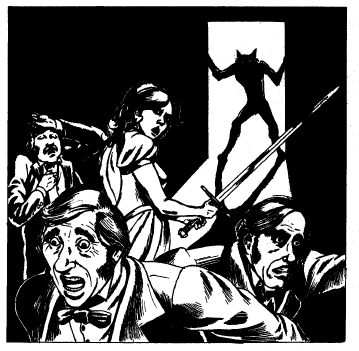
Are you boys cooking in here? Are you playing Sword Prom again?
I forgot that I never do a character creation chapter review without actually creating a character. The advice on character background comes after rolling scores, so I’m going to follow the tried-and-true, old-school D&D method of rolling scores, picking skills, and inventing a background after the fact. Let’s roll:
Strength: 76
Dexterity: 38
Agility: 66
Willpower: 60
Personality: 66
Perception: 46
Luck: 46
Stamina: 74
The skill roll gives me three skill points. I will spend them thusly:
Wrestling: Student (90%)
Modeling: Student (Base 72%)
Long-distance Running: Student (Base 89%)
Stuart Copeland, formerly known as “Leo ‘the Lion’ Londos,” is a former professional wrestler who retired comfortably in his late 30s after deciding he didn’t want to risk another injury. He’s a very talented individual who’s still a good collegiate wrestler and knows how to get along in any social setting. He became an envoy of SAVE after an appearance on a horror TV show led to a real-life encounter with the vengeful ghost of a former business partner. He doesn’t have an answer for incorporeal spirits or bulletproof vampires, but show him a zombie and he will drop that zombie on its head.
Wrestling, according to the Skills chapter, means that a good combat result automatically locks on a hold that inflicts damage, and can knock opponents down. I took Modeling because it’s this game’s only equivalent of the Etiquette skill. (It’s also based as much on Perception and Luck as Personality, so I’m not as good at it as I expected. Oh well.) Long-distance running ensures that if he can’t help you kill a monster, he can sure as hell leave you to die and get away while it’s eating you. More on these in the Skills chapter.
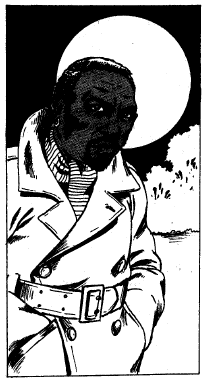
The moon is flying low tonight.
After the actual character creation rules, CHILL discusses equipment. It states flat-out that equipment isn’t meant to be important in this game, and that the CM will presumably forbid the characters from getting ahold of military firepower and bumbling around with it--besides, Dracula’s bulletproof, dummy. Encumbrance issues are largely left up to CM discretion. It’s noted that SAVE provides a standard pack of equipment for missions: A first aid kit, medical bag, cane or walking stick, lantern and oil, tape recorder, paper and pens, portable typewriter, reference books, camera and film, revolver with ammunition, and silver bullets and wooden stakes, “just in case.” They forgot a flashlight.
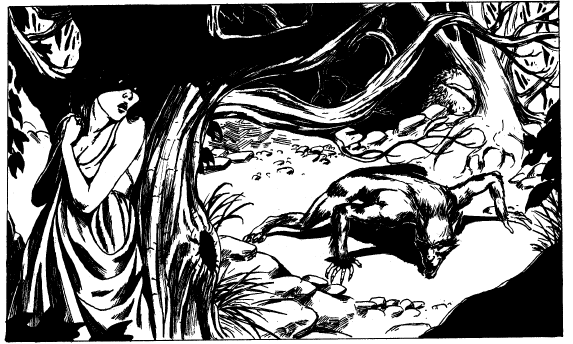
”Good thing I packed that silver portable typewriter.”
CHILL calls its experience points “Insight Points.” The CM is encouraged to give up to 50 points per session for good roleplaying, but this is dwarfed by the IPs you get for defeating monsters, however you defeat them. The IP haul from vanquishing a thread from the Unknown is the creature’s Evil Way score multiplied by its total number of Evil Way powers, and doubled if any of its powers are unique. A standard ghost can net over 1000 IP, split among the party. Thwarting a monster’s plans without destroying it is worth half its value, and vanquishing human or animal minions is worth 50 IP apiece.
Skills just come in three ranks: Student, Teacher, and Master, and can only be bought one rank at a time. Student is 500, Student to Teacher is 750, and Teacher to Master is 1000. You can also raise a Basic Ability score by 1 point for 500 IP, and learning new Art disciplines costs 1000. Players are likely to have skills coming out their ears before they start boosting Basic Abilities or supernatural disciplines. Advancement is meaningful and steady for characters who survive.
Next time, on CHILL: Monster-hunting Skills.
Skills!
Original SA post
CHILL: Adventures into the Unknown
CHILL Campaign Book, Chapter 3: Skills!
Skills in CHILL are a little funny, and not quite like any other RPG I’ve read, but they’re not at all difficult to figure out. Whatever skills you take, your base percentage chance to succeed is equal to one of your Basic Abilities, or the average of 2-3 abilities. Pistol, for example, is based on DEX, whereas Journalism is based on the average of PER, WPR, and LUCK (Perception, Willpower, and Luck).
Spending your skill points on a skill means you’re trained in it, and you get a bonus to the percentage chance to succeed. You can only spend up to three ranks on a skill, and get percentile bonuses as follows:
Student : +15%
Teacher : +30%
Master : +55%
So without supernatural aid, the theoretical skill score maximum is 135% if you have the relevant Basic Ability at 80. Having your Stamina and Willpower temporarily drained doesn’t affect the relevant skills, which is great because that would be really annoying to track.
Characters can “call a shot” whenever they use a skill--not just with combat skills, but by saying they want to find a particular piece of evidence or learn a particular detail about what they’re researching. Characters can’t use skills to build on the plot, though--it’s noted that you can’t find something that isn’t there. Characters can use their skills whenever they want, but CMs are advised to forbid characters from using research skills over and over until they succeed--fail a roll, and you can’t use the same skill to investigate the same subject for the rest of the adventure.
Want to use a skill untrained? For hand-to-hand combat skills it’s not so bad; you can use your Unskilled Melee stat to attack with bare hands or melee weapons. For anything else it’s pretty dire--it’s up to CM fiat whether you can even make the attempt, and your chance of success is your base score divided by 10 . If you succeed, you can’t do any better than an L (limited success) result.
When more than one Basic Ability makes up the base chance of a skill, it’s always the average of the two or three. Also, some skills require other skills before you can buy them--you have to be a doctor before you can be a forensic pathologist.
Combat Skills
Unarmed Melee
Boxing (STR+AGL): Boxing is pretty awesome, at least against other humans. Each rank in the skill gives you an extra unarmed attack per round, and any “K” result forces your victim to make a test against their current STA or be knocked out for 1d100 minutes and have their STA immediately reduced to zero.
Wrestling (STR+AGL): Wrestling is complicated, because you can trap your victim in a hold, which gets more severe as your attack results get better. An “H” result traps your victim in a partial hold, which does damage every round until they win initiative and make a successful attack, or a third party attacks you. While they’re in a hold, they can’t do anything but try to escape and they attack at -20. A “C” result is the same but with a -40 penalty, and a “K” result sends both of you to the ground. You can also try to strangle as a called shot; the rules for that are in Chapter 4.
Martial Arts (STR+AGL+DEX+WPR): Martial Arts is unique from every other skill in that each rank costs double Insight Points or skill points at character creation. Here’s why: It gives you extra attacks in the same manner as boxing. It allows your called shots to inflict the same kind of damage that guns and weapons inflict rather than “crushing” damage. At Teacher rank you can use your Martial Arts skill to fight with nunchakus, and at Master rank you can use it to throw shurikens, which breaks the usual rule against mixing melee and ranged attacks in a round. So a Martial Arts Master can break one guy’s arm, knock another guy unconscious, and throw a shuriken at two other guys.
Is this awesome and worth the double cost? I have no idea, because I don’t know how unarmed damage compares to weapon damage, and I don’t know if most of the monsters in the “monster manual” are even vulnerable to kung fu and ninja stars instead of fire, silver bullets, and wooden stakes.
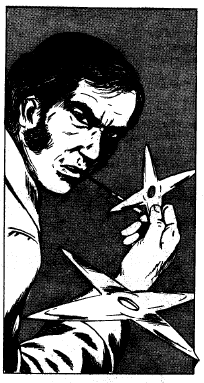
I never got my spot in that “Sabotage” music video.
Armed Melee
The skills for hand-to-hand weapons don’t even get descriptions, with the exception of blackjack. They add to your percentage chance to hit with them, you do whatever damage the weapon does. The end. I’d just like to call attention to the fact that you have to buy every type of melee weapon individually, down to distinguishing between 4 different types of sword skill. That’s pretty shitty when the difference between finding a cavalry saber or a rapier on the mantlepiece is using your full skill vs. your Unskilled Melee stat, which can be a cavernous gap.
Blackjack (STR+AGL): You can make a knockout blow your called shot; a “C” result knocks your victim to zero STA.
Dagger/Knife (STR+AGL)
Longsword (STR+AGL)
Mace/Club (STR+AGL)
Polearm (STR+AGL)
Rapier (STR+AGL)
Shortsword (STR+AGL)
Spear (STR+AGL)
Sword, 2-handed (STR+AGL)
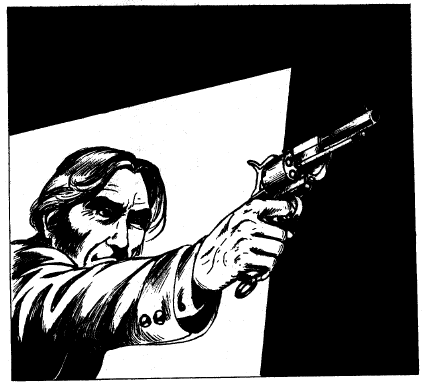
Let me tell you something, buddy--I’ve got you dead to rights, and nothing, I mean nothing, is going to emerge from the darkness and seize my outstretched arm.
Guns
Gun skills are pretty badass because they all use the same special rule: Each rank in the skill allows an additional attack, so a Revolver Master can fire four shots per round. I don’t suppose that helps you at all if you’re a Musket Master. The gun skills are even more ridiculously subdivided than melee skills--a separate skill for semi-automatics and revolvers? Really?
Musket (DEX)
Antique pistol (DEX)
Automatic pistol (DEX)
Revolver (DEX):
Rifle/Shotgun (DEX)
Automatic Rifle/Submachine Gun (DEX)
Bows
Bows also have a special rule: Each one takes multiple rounds to reload, which gets faster as you go up in rank. There’s a little chart I won’t reproduce here, but even Masters need 2 rounds to reload a bow and 6 rounds to reload a crossbow. Terrible, especially if you want to encourage players to use these things against vampires a la Tomb of Dracula.
Crossbow (DEX)
Longbow (DEX)
Shortbow (DEX)
Thrown Weapons
Thrown weapon skills pretty much suck; you don’t get any additional attacks. At least it doesn’t say anything about needing to spend extra rounds to draw throwing weapons. The only benny is that you can use any Throwing skill to hurl small, aerodynamic objects (like rocks).
Axe/Tomahawk (DEX)
Boomerang (DEX)
Dagger/Knife (DEX)
Javelin (DEX)
Spear (DEX)
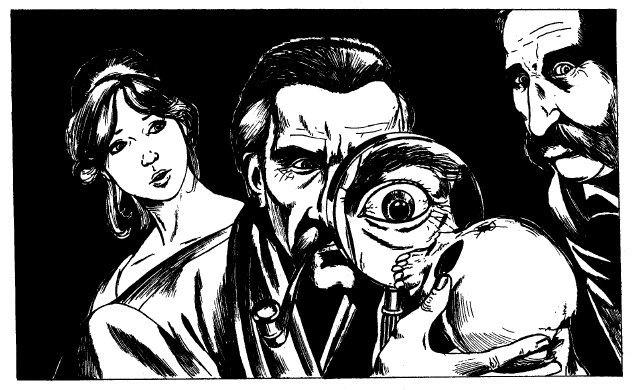
James? There’s a hole there, if you’ll just rotate it a bit--oh, you’ll get to it.
Professional Skills
Acting/Drama (PCN+WPR+PER): This skill does double-duty as both a research and a practical skill; it includes knowledge of drama and theatre, the ability to research dramatic literature and the history of theatre, and actual acting ability. The presence of this skill cries out for a “King in Yellow” scenario.
Anthropology/Archaeology (PCN+WPR): A research skill that includes limited knowledge of legend and folklore, but is mainly used to identify fossils and artifacts or to conduct archaeological digs.
Antiques (PCN+LUCK): Purely a research skill, you can use it to identify antiques of all kinds--jewelry, furniture, clothing, and all manner of household objects.
Art criticism (PCN+WPR): A research/knowledge skill for knowledge of art in general, and for identifying not only painting and sculpture, but also musical compositions, illuminated manuscripts, and architectural plans. You can use it to identify the artist by examining the work, and to detect fraud.
Biology (PCN+WPR): A straightforward knowledge/research skill that covers everything about plants and animals.
Geography/Cartography (PCN+WPR): Used for navigating via map, or for general knowledge of the local terrain, including familiarity with local floral and fauna and means of transport.
History (PCN+WPR): If it’s about the history of human civilization and doesn’t fit under another skill (or even maybe if it does), use History. It covers specific events, famous figures, belief systems and daily life, and developments in culture and science. As a research skill, you can use it to evaluate the accuracy and authenticity of historical documents.
Hypnotism (PCN+PER): A purely practical skill which you can use to hypnotize a willing subject. In true Van Helsing fashion, it’s mostly useful to help a character under the effect of a creature’s Evil Way powers.
The mesmerizer can put his subject in a trancelike state where they’re not affected by pain or strong emotions, cause the subject to recall any memory (even if it’s been “stolen” by a monster’s powers), to forget a specific event, or to reveal the name of a creature who’s mentally controlling the subject with the Influence power. You can also use it to plant a hypnotic suggestion to be triggered by a specific event later, but this can never be used to force someone to do something that they’d consider unethical or against their nature, so no Telefon shenanigans for you. This is one skill which SAVE monitors very closely, and using hypnotism for purposes other than combating the Unknown will get you bounced out of SAVE.
Investigation (PCN+WPR+LUCK): Your standard detective skill that police and private eyes use to conduct investigations. It’s noted as a historical context-sensitive skill that only includes techniques appropriate to the time period where the game is set; a pre-1925 detective won’t be able to dust for fingerprints. Using it requires you to call out the general subject of your investigation. It always takes a matter of hours to use; the result you get determines what you learn, and how quickly.
Journalism (PCN+WPR+LUCK): This one’s a little weird; it has a lot of miscellaneous functions. It grants all-purpose, shallow familiarity with topics in current events, such as the names of foreign politicians or the details of a sensational news story. You also use it to conduct research through news records and to learn about “mysterious events” by conducting interviews. It also implies at least a loose connection with news media that grants you press credentials, and at the CMs option, it can represent a base chance of the characters’ adventuring team having their exploits publicized (without violating SAVE’s code of secrecy).
Language, Contemporary (PCN+WPR): Each language requires a separate skill, and implies total fluency in normal circumstances--you only need to make a roll if you’re talking about complex technical subjects. It also doesn’t work for forms of the language more than 500 years old.
Language, Ancient (PCN+WPR): This is different from Contemporary Language; you don’t need to buy each language separately. Anyone trained in it can automatically read and translate Latin, Greek, Hebrew, and Egyptian hieroglyphics. You still need to make a roll to translate “obscure, ancient writings.”
Legend/Lore (PCN+WPR): Wow. You’re not even allowed to have this skill unless you have both History and Anthropology/Archaeology, and you have to have Teacher rank in one and Master in the other. It allows you the same knowledge of myth and legend that the other two skills provide, but what’s more, you can use this skill to determine how much of a legend contains actual truths about Unknown creatures and their Evil Way powers. I don’t think this skill should even be in the game.
Mechanics (PCN+DEX): You can use this to repair devices as complex as an automobile, build simple machines like pulley assemblies, and make minor repairs on electronics. Uh, what if you want to build a car?
Medicine (PCN+WPR+PER+LUCK): Medicine allows you to treat wounds (no roll needed), diagnose illnesses, create antidotes for poisons, and allow characters to heal twice as quickly while under your care (no check needed). An indispensible and straightforward skill.
Modeling (PCN+WPR+LUCK): This skill is, quite frankly, weird and dumb. You can use it in place of Personality for reaction rolls, gain access to important people, and gauge the reaction of a group of people to the characters. This skill does include actual modeling, but from the way it’s described it’s a “style and etiquette” skill. Unless you count Hypnotism, it’s the only purely social skill in a game that has four different skills for swords.
Photography (PCN+DEX): Used both to make good photographs, and to study photographs to identify details like time and place, angle, and whether or not they’re hoaxes.
Police Forensic Pathology (PCN+WPR+PER+LUCK): You have to be a Master of Medicine before you can take this skill. It allows you to perform autopsies, evaluate a body at a crime scene, and study evidence left on a body. I don’t need to explain how this works if you’ve watched network television in the past decade.
Psychiatry (PCN+WPR+PER+LUCK): Requires Medicine at Teacher rank. You can use it to diagnose NPCs who are “apparently insane” and find out if they’ve actually been in contact with the Unknown. No actual, real-world uses for this skill are ever mentioned, and they more-or-less admit that taking this skill is just an invitation for the CM to “flavor the plot” with some “madmen” NPCs. Apparently, CHILL doesn’t deal with madness in anything other than the “babbling guy in Hammer horror film” trope.
Outdoor Survival (PCN+WPR+LUCK): Used to find fresh food and water, build shelter and fires, and protect yourself from natural hazards while in the outdoors. A survival expert can keep the entire party healthy without any supplies.
Tracking (PCN+LUCK): Used to follow the trail of animals. (I assume it works on people, too.)
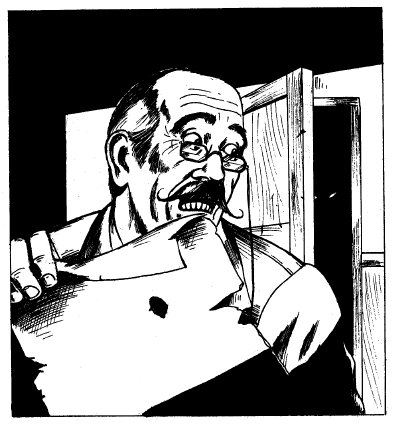
”The Horror in the Publisher’s Clearing House,” by Ramsey Campbell
Common Skills
Disguise (PER+DEX): This one covers both crafting a convincing disguise as well as imitating someone else’s mannerisms, but you also need the Acting skill if you’re going to carry out any serious impersonations.
Explosives (PCN+DEX): You use this to transport and employ explosives without killing yourself. CHILL states outright that the CM shouldn’t let you get away with using explosives as a standard weapon--it should be used for things like destroying structures of gaining access to places like caved-in mines. An incomplete success can result in things like using too much explosive, collateral damage to the environment, or catching yourself and the rest of the party in the blast. Oops.
Filching (PCN+DEX): For picking pockets and pocketing small objects without being seen. When used to pick pockets, it’s opposed by Perception. SAVE forbids stealing while on mission unless it’s necesary to further the mission.
Gambling (PCN+LUCK): CHILL tells us outright that wealth isn’t supposed to be important, so this skill shouldn’t be used to let characters amass wealth. Rather, it allows them to carouse and associate with criminal types without going broke, since the house always wins in the end. Using it requires you to state how much your staking, and contrary to everything we’ve just been told, good rolls can lead you to winning 10 times your stakes.
Graphology/Forgery (PCN+DEX): Pretty much exactly what it says, this skill allows you to analyze and forge handwriting.
Lockpicking (PCN+DEX): For picking locks and cracking safes. Failure means you can’t get through that lock, ever, until you increase your skill.
Long-distance running (STA): Oh, boy. This one requires you to check your score against the Action Table to determine how many hours you can keep up a steady pace, and at how many miles per hour. This skill also reveals that that note about not having to reconfigure your skills when your Stamina is drained was a lie, because it’s based on current Stamina.
Swimming (STA): Like long-distance running, but in water.
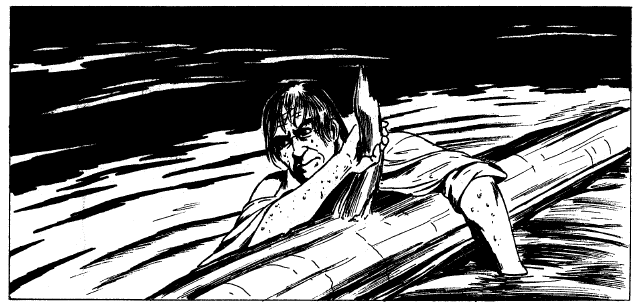
Oh, alligators. Well, that’s just great.
Those are all of the skills in CHILL. Granted, it does cover all the bases for what the players need to do, and I like the way it actively discourages the CM from allowing characters to do things like toss dynamite around just because they have a skill. On the other hand, the skill list is a pretty good example of baroque old-fashioned design, with too many combat skills and too few social ones. Most of what I've been told about CHILL indicates that it's a game where cleverness matters a lot more than a Submachine Gun 100% score to beat monsters, on whom many mundane weapons just don't work. But the monster booklet is a ways off! In the next chapter, CHILL explains the rules to handle things like time and distance, injury and healing, and the combat rules for employing all those juicy shuriken-tossing, zombie-rasslin' skills.
Next time, on CHILL : “Characters in Action” with James Lipton.
Characters in Action
Original SA post
CHILL: Adventures into the Unknown
CHILL Campaign Book, Part 4: Characters in Action
I’ve been putting off this chapter for awhile, because it starts out pretty boring. Little did I know that when I actually sat down to do it, it would be downright painful to sort through. This chapter covers the combat rules, sure, but also a lot of stuff I’ve never liked keeping track of in RPGs, like overland travel and exactly how individual characters can move. To clarify my perspective, I believe that if you design an RPG that has separate derived stats for things like exactly how much a character can deadlift, bench press, high jump, and long jump, and how fast they can walk, jog, run, swim, and climb, the Roleplaying Police should come to your house and see how fast they can punch you in the face.
This chapter on “characters doing things” gets very poorly-organized as it goes on--for example, the sections on “Order of combat,” “How to roll attack and defense,” “modifiers for combat,” and “how to determine damage” are separated and interspersed with sections on combat movement and car chases.
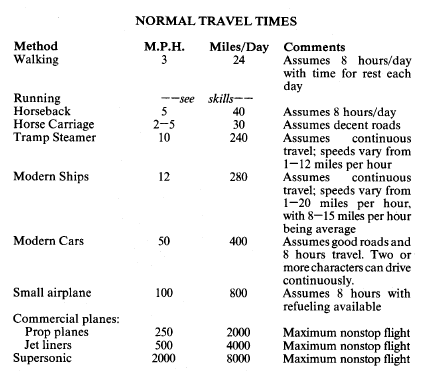
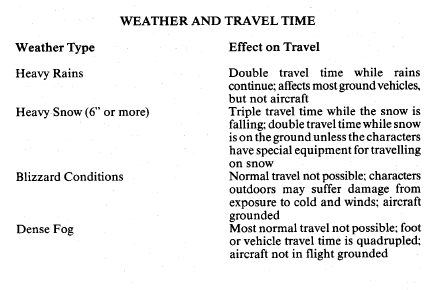
Not covered: Hovercrafts, pogo sticks, or Segways.
Nonetheless, the chapter starts off with some good common-sense advice for the novice CM, noting that the real-time to game-time ratio increases rapidly when you’re dealing with combat or, to a lesser extent, hazards and investigation. It recommends the CM treat game-time in day-long units, and if the characters are traveling significant distances or using their skills to conduct research and investigation, they should only be allowed two or three activities per 12-hour period. There are tables providing a summary of long-distance travel times and the effects of bad weather--maybe that’s helpful for establishing the plausibility of some kinds of adventures, I suppose, but I doubt anyone ran a game of CHILL and said “Sorry, Dracula killed Mina while you were 27 miles from the train station.”
Rounds
CHILL doesn’t exactly have a section labeled “combat.” The CM starts dividing action into “rounds” whenever the characters encounter a creature or are in a situation that demands careful measurement of game time. I like this; it gets people playing CHILL in the mindset that there are kinds of action sequence besides fights.
Rounds are either 5 seconds (combat) or 1 minute (noncombat). Once gameplay devolves into rounds, it follows an official Sequence of Play:
1. The CM declares what any NPCs are doing, and what the characters can plainly see. (If an Unknown creature is going to use an Evil Way power, that’s kept secret.)
2. The players decide what their characters are doing. You can’t change it later (although if you have an ability that gives you multiple attacks, you only need to declare the first attack). The first two steps are where all characters “call their shots,” that is, state what they ideally want to do.
3. Roll initiative. The CM rolls 1d10 for the NPCs, and one player rolls 1d10 for the party. Reroll ties. The winning side is Side A, the loser is Side B.
4. Side A uses Art or Evil Way powers--characters act in order of highest to lowest Willpower. Using the Art takes up a player character’s entire round, but Unknown creatures with multiple attacks don’t have that problem.
5. Side A fires ranged attacks--again, in order of Willpower, subject to CM discretion. If you have multiple ranged attacks, you make them all at once--none of this “everybody gets an attack before anyone gets multiple actions” fairness garbage. You can hold one ranged attack in reserve for “defensive fire.”
6. Side A moves. Reference is made to moving your tokens on a map, though I’m not convinced CHILL is a game that ever really needs maps and tokens.
7. Side B “defensive missile fire.” Each ranged attacker on Side B can make one (only one) ranged attack, which counts toward your total.
8. Side A melee attack: Self-explanatory, and works the same way as ranged attacks.
9. Side B uses the Art: Same as above.
10. Side B fires ranged attacks: You can make any leftover attacks now.
11. Side B moves.
12. Side A defensive fire: If anyone from Side A held a ranged attack in reserve, they can make it now.
13. Side B melees: Same as above.
14. Stamina loss and recovery: If any characters are going to recover or lose Stamina as a result of healing effects or wound effects at the end of the round, you make note of that now.
Except for the defensive fire thing, it’s not as complicated as it looks. The precedence of actions is “Magic, ranged, move, melee.” The defensive fire strikes me as odd for two reasons: first, it complicates play, and second, it seems to be a nod to tactical realism in a game that doesn’t necessarily need it. After all, you can just as easily run into trouble charging into melee as charging a guy with a gun. Letting characters resolve multiple attacks in rapid succession seems like a quick trip to making combat very lethal, and making multiple attacks the ultimate force multiplier that every combat-oriented character will want to get.
There’s a fair bit of information on visibility--something that is likely to affect characters, but almost never affects creatures of the Unknown, who are assumed to have night-vision by default.
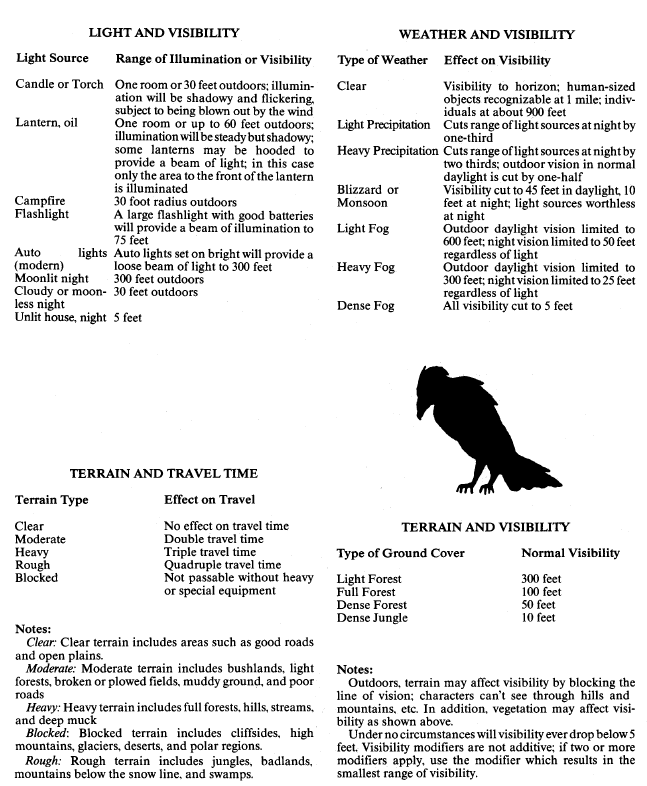
Can you guess the probability I’d ever consult these in play? It’s a number between 1 and -1.
We’re reminded that Willpower and Stamina are the two ability scores which can be drained and restored during play, but the only skill scores affected are Long-Distance Running and Swimming. Don’t worry, you’re safe from Dracula as soon as you get in the water.
Fear checks are important. It’s a (current) Willpower roll you have to make when you sense the presence of an Unknown creature or a threatening, dangerous animal, like a snarling wolf. CHILL also suggests that you require a Fear check if the player reacts with obvious fear to something that happens in the game, like a door creaking slowly open--this is terrible, horrible, no good very bad advice for a number of reasons, and I hope anyone and everyone who ever played CHILL disregarded it.
Each character only has to make one Fear check per encounter. Creatures have a Fear stat, and if there are multiple creatures, you check against the highest. Being outnumbered by the creatures can increase the difficulty by one or two columns. Here’s the good news: If you’ve encountered that type of creature before, you lower the column by 1, and once you’ve successfully helped to destroy or defeat a creature, you never have to roll Fear checks against its type, ever again. Record the types of creepy-crawlies you’ve busted on your character sheet like a trophy, sun.

I ain't afraid of no Undertaker.
Failing a Fear check results in the character losing 2d10 Willpower and fleeing in panic--at the CM’s discretion, it might be more logical for you to hide or do something else, if you can’t run. “Success” isn’t necessarily great, either. An S result still results in losing 1d10 Willpower and fleeing for 1 round, L gets you half of that and a round of fleeing, an M result still costs you (1d10)/2 Willpower, and only an H or C result allows you to stand your ground without being shaken.
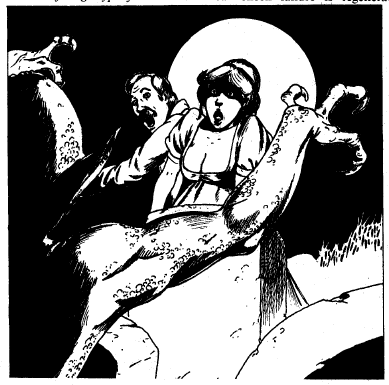
"Charles! It's him! The creature who stole our necks!"
To be honest, I don’t really like the way Fear checks shake out in practice. Especially if you’re taking the terrible advice about having the players roll if they actually act scared in a game that’s supposed to scare them, having half the party run away flailing their arms if they meet a vampire, a mummy, or a creaky door is more like Abbott & Costello Meet the Mummy than a real horror film.
Surprise checks , at least, are simple: When potentially ambushed, affected characters make a Perception check, and those who fail can’t act for the round, though they still make defense rolls. The ambusher’s stats are irrelevant.
You can attempt to distract enemies in combat. It requires spending a point of Luck (permanently) and describing a clever method of distracting the foe--if the CM allows it, the enemy is subject to a surprise check as normal. Only player characters can attempt distractions.
CHILL starts getting really tedious when it establishes different rules for ranged and melee attacks, and divides them into different sections with a bunch of other crap interspersed. I am about two minutes from putting my fist through this iMac, so the rest of this chapter comes in a separate installment!
Next time, on CHILL : “Characters in Action” Part 2: Attack rolls, moving in combat, speeds for things like crawling and leaping, vehicle speed, combat modifiers, combat results, damage, poison, illness, and healing. In that order .
Characters in Action, Part 2
Original SA post
CHILL: Adventures into the Unknown
CHILL Campaign Book, Part 4: Characters in Action, Part 2
The Combat Procedure is the official name for how you resolve attacks during that 16-step process, and goes into excruciating detail describing something any kid can figure out. It’s an eight-step process itself, but most of it is breaking down a lot of “well, duh” into too many separate points, so I’m going to summarize it.
To determine the outcome and damage from an attack, the attacker must roll to find his Attack Column and the defender must do likewise to find his Defense Column.
Attacker: Declare your attack, call your shot, find your percentage chance (it’s your skill, duh!), calculate your “Strike Number” (a needless term for “your actual percentage chance after applying modifiers”), and roll the percentile dice. Roll over your skill, fail. Roll under, take the margin and, and find the corresponding row on the Action Chart. (Yes, the Attack Column is actually an Attack Row. Don’t these guys know Excel?)
Defender: Kind of like in the new World of Darkness rules, there’s no Dodge skill and your defense against ranged attacks is based on dumb luck--roll 1d10, the result is your Defense Column. For melee attacks, if you’re a melee attacker this round, your column is based on the skill you’re using. Otherwise it’s based on your Unskilled Melee (if you’re a ranged attacker or doing something else) or 1 (if you’re surprised or scared).
I think CHILL’s author, Michael Williams, must have had the power to see into the future. He knew I was going to review CHILL, and he personally hates me. That’s why he decided to interrupt the section that explains attacking and defending with a long, tedious section on movement in combat.
Joke’s on him, though, because you can figure out how the columns work using the Action Chart which we’ve seen twice already:
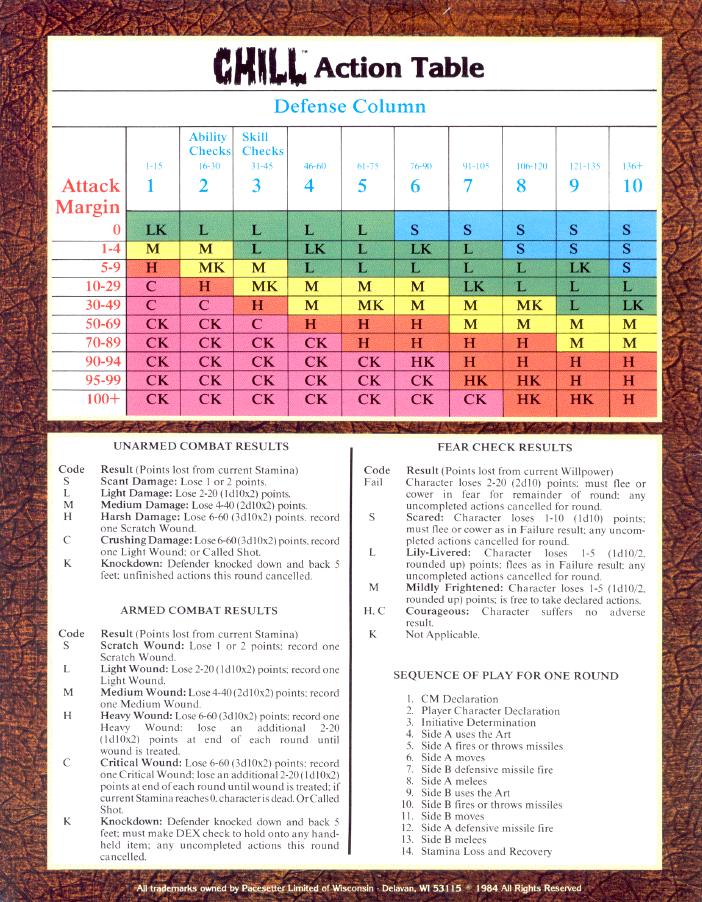
Cross reference the attack result with the defense result, and the notes underneath tell you how much damage is done. As you can see, fists and feet can inflict as much Stamina loss as guns and knives, but weapons inflict Wounds (more on those later) and can bleed you to death. With any attack, a C result gets you your called shot effect.
For a horror game, CHILL is rather hung-up on movement . It recommends miniatures and maps with five-foot squares for areas, and promises future supplements with hex maps for overland travel. Oh joy.
There are charts showing character speeds for crawling, walking, running, sprinting, swimming, and climbing, not to mention distances for jumping and leaping. Thankfully, these aren’t derived stats; if you’re counting movement in 5 foot squares, CHILL characters get movement comparable to D&D characters.
To a point, these are useful--instead of having different types of actions (like D&D 3e/4e), CHILL just requires you to “spend” squares of movement to go down stairs, maneuver around furniture, open doors, stand up, keep watch behind you, or fling obstacles into your wake to slow down pursuers. I have to give them credit; CHILL pays attention to bits of rules that are relevant to its milieu.
There are also rules for movement in vehicles. There’s a chart for vehicle speeds and “safe speed” based on conditions--if you fail a fear or surprise check, or drive at unsafe speed for a few rounds of combat, you have to make a vehicle skill check or have an accident, which is treated as an armed attack against all passengers with an attack skill of 100% and your defense column based on the speed of the vehicle. A 100mph car crash can really fuck you up, but what happens to the vehicle is up to CM’s discretion. The rules only assume cars, by the way--there’s nothing about more or less damage from motorboating accidents or helicopter crashes.
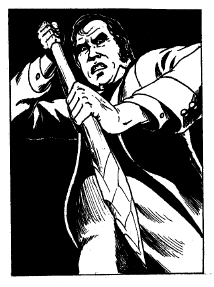
I had to read five pages of rules to learn how deep I can stake this tent.
Combat modifiers ! CHILL makes a wise move, in my opinion, by getting around the complicated issues of who’s doing what on which initiative count by assigning penalties based on what you and your target have declared for the round. For ranged attacks, you take penalties for attacking targets which are moving, covered/concealed, or going for cover. You also take penalties for firing while moving, firing at long range (by weapon type), quick-drawing and firing, and on your additional attacks, which really should’ve been mentioned earlier. Two characters can easily have a tense, prolonged shootout by firing at each other while diving for cover.
Firing at someone through a crowd requires a Luck check, and firing into melee requires a C result instead of randomly shooting one of the combatants. Shooting a helpless (unconscious, tied up, etc.) target results in instant death, but PCs get a Luck roll to appear dead but have a chance of surviving.
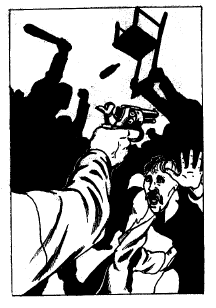
Not the chair! Shoot me instead!
Melee modifiers are less complicated, but more silly. Attackers take penalties for attacking from the ground or while getting up (silly for grappling) or if they moved to close the distance this round (silly in all cases). You get bonuses for attacking from behind, attacking a fleeing opponent, or charging with a long weapon, and there are special rules for holds and strangulation.
Now that we come to the weapons table, I realize that weapons don’t have damage. The only way increased damage is reflected in a weapon’s stats is that bigger weapons have longer ranges, and thus give bonuses to the to-hit roll at shorter ranges. If someone’s within melee range of you, though, a pistol’s as good as a rifle, and melee weapons are only distinguished if they’re long, thrusting weapons usable for charging.
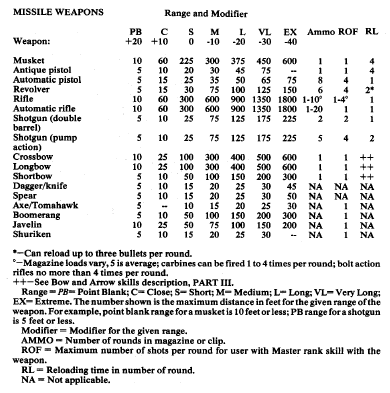
No flamethrower?
Damage comes in two types: Stamina loss and wounds. If your Stamina drops to zero, you fall unconscious for 1d100 minutes. A friend can wake you up and restore you to Stamina 1, no skill or roll required. Unconscious characters with a Heavy Wound will have that turn into a Critical Wound if untreated. Wounds are a different story--you only have so many wounds of each level. Light Wounds overflow into Medium Wounds and so on, and any character with a Critical Wound who drops to Stamina 0 is dead.
There are special rules for damage from falling, calamities like fires and explosions, or exposure to the elements. They’re actually simple--it’s treated as an attack with a base chance of 100% with modifiers for height, CMs discretion about the intensity of the explosion, etc. Exposure is read against Defense Column 5, but the others are randomly rolled as for a gunshot. A fall or a fire can hurt you bad.
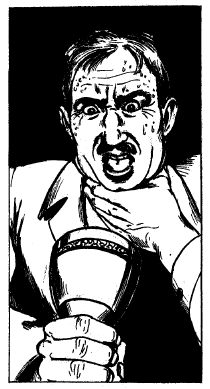
He chose...Mountain Dew.
Poison also has special rules, and that’s important because there are a lot of venomous animals and monsters. Poisons are actually treated as if your Stamina score is attacking the poison, with a check against your Current Stamina and the Defense Column based on the strength of the poison. The Action Chart result you get results in anything from no effect to death in seconds. There are disease rules which work the same way, except that even the worst result is slower acting, inflicting a Critical wound and 1d10 Stamina each day until you die.
Healing injuries is time consuming. If you lose Stamina to things besides damage, such as wearing yourself out by running away from a monster, you actually regain a few points every round (found by checking the Stamina total as a Defense Column value--the human range will be 1-6 points). This is a bad idea in practice, since you have to keep track of two kinds of damage. You regenerate Stamina loss from injuries at half this rate, rounded down, per day. If you want to heal Wounds, they require a day of bed-rest per Wound.
Lost Willpower is easier to regenerate--10 points per night of decent sleep. Having low Willpower is crippling, though. If your Willpower drops below 20, you’re too shaken up to fight or investigate the Unknown--you just want to retreat to safety and sort yourself out. People with Willpower 0 are so badly shaken they can’t do anything but follow simple commands like “come here” and “sit down.”
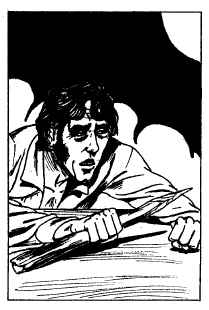
That’s it. No more wand parties for me.
So that's the movement and combat rules. A little spergy, perhaps, but at least there's no Head Butt skill.
Next time, on CHILL : Halloween Jack presents the award for Chapter 5: The Supporting Cast. And the winner is...Claude Rains, ladies and gentlemen!
The Supporting Cast
Original SA post
CHILL: Adventures into the Unknown
CHILL Campaign Book, Part 5: The Supporting Cast
By and large, this chapter is on handling NPC reactions--and showing you that you can use the Action Table for things other than combat.
Animals are simple enough. Reaction rolls are required when the animal is threatened, or when it senses the Evil Way (which all animals have a 20% chance of doing). Roll a percentage, subtract 20, check as an “attack” against defense column 4. The result indicates an animal that is anywhere from skittish to violently hysterical. Characters can try to calm animals; this is treated as a Personality “attack” defended by the animal’s Willpower.
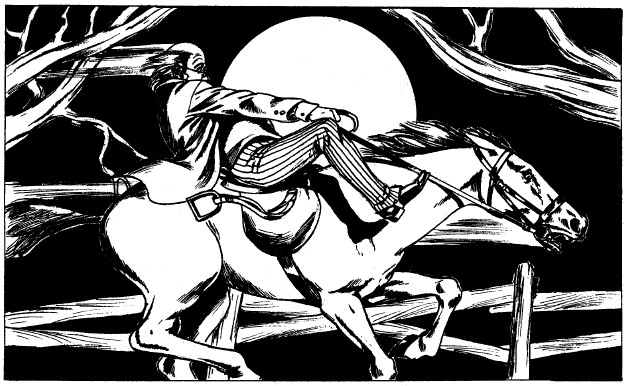
No caption necessary. Poor horse.
For minor NPCs , CHILL provides a d100 chart to randomly roll the character’s attitude, giving results such as “annoyed,” “bored,” “efficient,” “flirtatious,” and “nervous.” These have no hard and fast rules associated with them, and are there to give bit players a little personality. Every serial killer movie needs its befuddled cop and droll coroner, after all.
Reaction rolls for “major NPCs” are more complex. First the CM can roll a situation check, which is basically a dumb-luck roll regarding how deeply interested the NPC is in the PC’s presence, for good or ill. Roll a percentage, subtract 20, and check against the NPC’s Personality to indicate something from Slight Interest to Friendly/Hostile Reaction. This is weird, as it implies that more charismatic individuals are less bothered by what other people are doing. The example given is of a policeman hearing the PCs’ gunshots and running in--if he’d rolled differently, he’d still respond to the situation (because it’s his job) but he wouldn’t give a fuck that he just heard gunfire, apparently.
A direct action check is when you’re trying to deliberately influence a NPC. The PC uses Personality as an “attack” stat against one of the NPC’s stats, depending on what they’re trying to do--against Personality for requesting help, Perception for deceit, or Willpower for persuasion and intimidation. Your column result determines how much effort the NPC will expend to do as you ask, if at all.
Bribery is also a thing which gets its own special rule. NPCs normally have a 70% base chance of being honest, meaning that the bribe will fail outright and the NPC will be outraged. If it even works, the bribe has to be a certain amount to be worthwhile ($10 for a cop, $100,000 for a high-ranking politician). Bribery sucks, don’t bother! If only corruption was so difficult in real life.
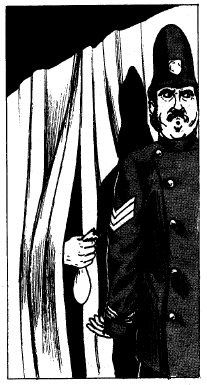
Constable Barlow is bribed into assisting a classic whoopie-cushion prank.
The CM might let PCs develop close friendships with NPCs, which requires a direct action check; a C result gets you a friend for life. “Friends” won’t be your constant companion, but they’re loyal unto death. In a twist on old D&D rules, you can only have one such friend for every 10 points of Personality.
PCs can try to deal with intelligent creatures of the Unknown using the standard reaction rules, but with a -20 penalty to Personality--more importantly, Unknown creatures will never abandon their goals, give up their valuables, or morally reform themselves--we haven’t gotten to the creature book yet, but I’m getting the impression that CHILL monsters are always evil, and none of them want to be your sparkly boyfriend, ever.
There are special rules for trying to convince an ignorant NPC that something supernatural is going on, and they are overcomplicated and stupid. Roll three dice. If the first die rolls 10, the NPC is willing to listen. If the second die also rolls 10, they’re open to the possibility. If the third die also rolls 10, you have actually convinced the NPC. So you have like a 1 in 1000 chance to convince someone of the supernatural, and your stats and roleplaying have nothing to do with this at all.
Last in this chapter is a page on how social institutions fit into the background of a monster-hunting game. CHILL encourages the CM to keep in mind how society will react to people running around with guns and stakes, but it’s clear that, as with money and cross-country travel, the minutiae of dealing with civil authorities isn’t supposed to take up too much time away from investigation in a CHILL game. The book talks about civil servants, police, clergy, the military, the business community, and the press, but basically just repeats itself saying “These people are interested in the general welfare of society, but are not going to buy into the idea of supernatural threats.” Clergy are more likely to be openminded about the existence of supernatural evil, but they’re not going to go on a crusade with you. The only kind of journalist who will take interest in the PCs’ activities are Weekly World News types.
In the event that the PCs run afoul of the law, CHILL recommends you handle the process with a Luck roll to determine a guilty or innocent verdict, and allow other PCs to make a Journalism or Investigation roll to add +10 Luck per success. The whole process takes 1d10 days, which CHILL admits is ridiculously fast, but not as ridiculously boring as roleplaying out a lengthy criminal trial for breaking into an abandoned house while inexplicably carrying a half-ton of occult knick-knacks and antique weaponry.
Next time, on CHILL : “The Art,” a classy way of saying kewl powarz.
The Art
Original SA post
CHILL: Adventures into the Unknown
CHILL Campaign Book, Part 6: The Art
When SAVE envoys and other people in the know talk about the supernatural, its in terms of the Known World and the Unknown. The Art is the ability of human beings to perceive and interact with the Unknown. The Art is supposedly not magical, but a way to channel mysterious and poorly-understood energies from the Unknown universe into ours. Whatever, its magic.
PCs have a chance to sense uses of the Art (including the Evil Way) or Unknown creatures, which leave traces of Unknown energy in their wake. The base chance is ⅕ your Perception score, and only within 30 feet. This isnt passive, though; you have to declare it and spend a round concentrating. It isnt time-bound, so you can try to detect if a place or an object has been touched by the Unknown at some point in the past, but the CM is encouraged to give you vague answers.
There are four forms of the Art, and when youre using associated powers you treat them like a skill:
Communication (PCN + PER): Telepathy and psychic sensitivity.
Restoration (PCN + STR): Healing and boosting physical capabilities.
Protection (PCN + LUCK): Shielding you from Unknown abilities.
The Evil Way : Evil powers reserved only for creatures of the Unknown.
Each form of the Art has three disciplines (specific powers) associated with it. You cant possess the Art unless you have at least Perception 60 and Willpower 50. If you meet the requirement at character creation, you can choose one discipline for free. The rest cost experience points, and you have to learn all the disciplines from your initial form before you can branch out. Dont get excited, though; none of these powers are going to turn you into a fireball-slinging, Dracula-frying wizard.
You can spend Willpower to increase your chance of success on a 1-to-1% basis, but its limited by your current STA, and 30 is the maximum.
Communication
1. Telepathic Sending : You can send a brief (seven words or less), one-way message to any living, sentient mind on the planet. You can only do it up to twice a day, and it doesnt work on the undead. Language barriers are no problem.
2. Telepathic Empathy : You can read the emotions of any character or creature. It says it works at any distance and doesnt say anything about line of sight, so you can blow 2d10 points of Willpower to find out how Draculas feeling, I guess. All you get is emotions and how strong they are, and nothing about thoughts, motivation, or how the emotions are directed, so this is a pretty useless power.
3. Clairvoyant/Prescient Dream : Once per week, you can try to have a dream which will either reveal some kind of useful clue or reveal whats going on in a different place. The clues are often revealed in a metaphorical way--the books incredibly dumb example is an aunt walking around in a fur coat, which may mean that shes secretly a werewolf, or that shes traveled a fur piece to visit you. Ho, ho, ho. Using this discipline costs 2d10 Willpower.
Restoration
1. Restore Stamina : What it says on the tin. You restore 1d10 Stamina to any person or animal. (It doesnt work on monsters.) It also stabilizes characters who are bleeding out from wounds, and negates poison. You cant use this on yourself, and a target can only benefit from this power once a day. You also have to touch the target, and neither of you can do anything else that round, so no laying-on-hands to an ally while hes laying down cover fire.
2. Restore Willpower : Same deal. Restores 1d10 Willpower, with all the same limitations as Restore Stamina. Not as good, since you wont need this to stop you from bleeding to death.
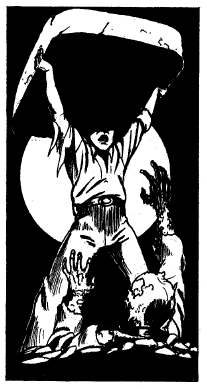
Who ordered the deep-dish?
3. Feat of Strength : If successful, you can perform a great feat of strength, lifting up to 1000 pounds for one round. Using this discipline costs 2d10 Willpower, and while you can maintain it from round to round, you have to reroll and spend Willpower each time--you really dont want to be lifting a boulder over your head when you fail a roll. Although this discipline has an illustrated example of a guy about to crush a zombie with a massive block, it doesnt say anything at all about using this power to strike a mighty blow or use a huge object as a weapon--it doesnt directly affect your Strength score.
Protection
1. Raise Perception : Another aptly named power, this raises the Perception of all PCs in sight by 10 points. However, it doesnt affect the user, doesnt affect skills, and can only be used twice a day, lasting 1 minute. Not very useful, although its nice that it affects most of the party.
2. Mental Shield : Another power that works twice a day for 1 minute, it raises the mental defenses of all party members against uses of Evil Way Subjection powers, which we havent read about yet. PCs already affected by Subjection powers get to make a general Willpower check to throw them off.
3. Sphere of Protection : This creates an invisible, spherical force-field which automatically nullifies all missile attacks (while allowing you to shoot out). It has a 15-foot radius, and monsters cant enter the sphere at all. Even better, if you throw up the sphere so that a monster is inside it, they must immediately attempt to leave. If for some reason they cant, they run as far as they can and are unable to defend themselves; any successful hit on them gets an automatic C result. The only bad news is that it costs 2d10 Willpower and only lasts for a round, unless you keep making successful checks and keep spending Willpower to keep it up. Still, if you can corner a monster in its crypt, you can have yourself a good ol hillbilly beatdown on Dracula.
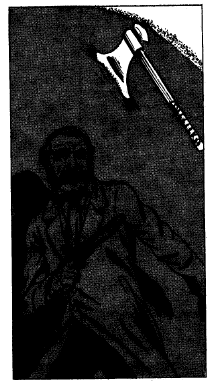
Granted, that would have missed anyway.
SAVE Organization History
This chapter concludes, incongruously, with a brief history of the SAVE organization, supposedly written by a scholar named Dr. Desmond Kearney.
The modern history of the Art began in 1789, when a Spanish doctor named Alfredo Ruiz was looking down at a nearby beach through his telescope. He saw a group of Arab sailors about to be ambushed down the road by a group of bandits hiding behind rocks. He fervently wished there was some way he could warn them in time, and received the psychic message You have, friend. Thank you. He managed to track down the sailors, but could not interview them because none of them spoke Spanish. SAVE believes that the legends of characters like Circe and Merlin are based in real practitioners of the Art, though they cant document it to their satisfaction.
SAVE itself was founded in Dublin, Ireland by a scientist named Charles OBoylan. After recording a series of related events that had been recorded by reputable scientists but ignored by the scientific community, he developed an intricate theory--that there is a set of interrelated natural laws we dont yet understand, that strange energies related to these laws emerge from some sort of fourth dimension or parallel universe, and that this alternate realm is host to a highly disciplined, intelligent evil force that intrudes into our world to wreak havoc.
OBoyland founded SAVE to study the Art and more importantly, to combat the evils from the Unknown. He recruited a number of scientists and explorers, including Henry Boulton and Lord Strange. Unfortunately, they were never able to conclusively prove the existence of the Unknown to the public, as Unknown creatures and the effects of their powers simply vanish when theyre killed. OBoylan organized one last mission to Cairo with the goal of digging up conclusive proof of the Unknown and restoring his reputation as a scientist. No one came back. In the aftermath, the leaders of SAVE decided to take the society underground. They took recruits from people who had had a verifiable encounter with the Unknown and who were willing to abide by the code of SAVE, which requires setting aside ones job and any philosophical differences to protect humanity from the Unknown.
All PCs are assumed to be SAVE envoys. SAVE isnt rich in resources, but is very rich in information regarding where to go, whom to contact, and how to prepare for a battle with the Unknown. If a PC betrays SAVE to the public, no one will believe them, and the Unknown has no interest in exposing SAVE (and potentially Itself). Getting booted out of SAVE is a virtual death sentence; no one expelled from SAVE has survived longer than 17 months--believed to be the result of Unknown enemies catching up to them.
The rules of SAVE are:
1. Keep SAVE and all related activities a secret. If youre arrested or detained for any reason, SAVE will help you secretly if it can, but never publicly.
2. To maintain the highest ethical principles, that is, respect local laws, customs, and cultural differences.
3. Document everything you can about the Unknown and send it to SAVE.
4. You must be willing, at any time, to drop everything and fight the Unknown.
5. Failing to follow these rules may result in dismissal from SAVE.
SAVE maintains its headquarters at the ancestral OBoylan estate in Dublin, which houses their central archives, maintained by a full-time employee, former professor Dr. Wilhelm Geistmann (seriously). SAVE maintains correspondence only by mail, and only rarely is anyone invited to visit the archives. SAVE envoys identify each other by wearing some form of the indalo, a primitive symbol native to Almeria, where Dr. Ruiz first used the Art.
SAVE helps PCs primarily by providing them with the adventure hook and with information. In fact, CHILL tells us that after the first few sessions, you may as well let players read the contents of the Horrors of the Unknown book, as theyll know all that stuff. I disagree sharply . SAVE is mainly useful as a plot device; they can provide clues when the party gets derailed. (On the other hand, SAVE's information about monsters and such is not always accurate.) Theyre not entirely without resources, either; SAVE can provide things like hotel rooms, safari gear, an all-terrain vehicle, or in extreme cases, legal aid and up to $10,000 in cash.
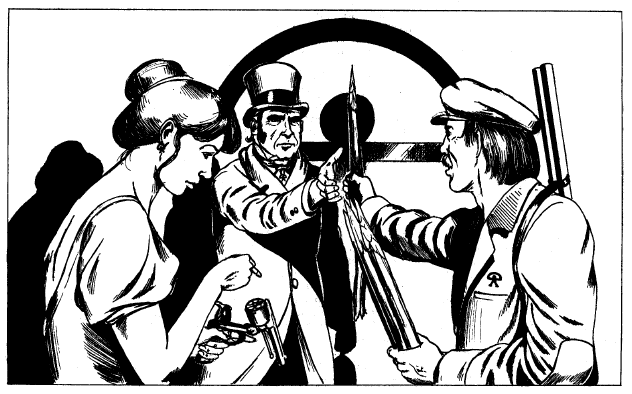
Everything tasted like sawdust for a week.
Next time, on CHILL : Horrors of the Unknown! We will know about the Unknown, and if we can beat it with karate.
Running CHILL
Original SA post
CHILL: Adventures into the Unknown
CHILL Campaign Book, Part 7: Running CHILL
Up to this point, CHILL has just been a fairly ho-hum game with a system that's simple and serviceable enough, but without any really unique rule mechanics that distinguish it as a game. That's a shame, because you'll see that where the game really shines is in its GM advice and in the way its monsters work. (The monster book is also where they spent their art budget.)
CHILL does that shit every old RPG does where it tells you that your job is to be the eyes, ears, nose, heat-sensing pits, etc. of the PCs and to know how the rules work, but it emphasizes being able to tell the players what's going on. You're encouraged to use the NPC generation rules (and charts and other stuff) ahead of time so you'll have a grasp of what your major NPCs are doing, but it's more important to be able to react to the players' ability to trying anything and everything. There are only two "rules" in CHILL's refereeing chapter, and they're touted as the most important rules in the game.
1. The CM's job is to make sure everyone has fun. You aren't the players' enemy, you're just acting like it sometimes. Stay neutral and let the players succeed or fail, even live or die based on their decisions, because the real fun of the game is for them to be really scared but then find a way to win on their own.
2. The CM has the power to change or ignore any rule or result in order to facilitate the above, as long as it's fair and consistent.
CHILL says outright that while they sell adventure scenarios, you're going to want to create your own sooner or later. You're encouraged to read classic horror literature (Stoker, Shelley, King, Straub) and watch horror movies that don't rely on gore, like the work of Hitchcock. Often, you can choose a monster you want to use, and their Evil Way powers will form the basis of the situations you want to stick the players in. Creating your own creatures isn't hard either; you're advised to determine one or two features that make the monster uniquely scary (or what's the point?) and then assign the stats and Evil Way powers based on that. If you want to design a creature that's going to be an "ultimate bad guy," put some thoughts into its plans and motivations.


CHILL places a lot of importance on game balance, which it asserts is not that hard. Essentially, pay close attention to the stats and Evil Way powers you're giving to the enemies, especially the latter. When in doubt, err on the side of the players, because you can always automatically give the monster some more Stamina or Evil Way points, or increase its damage, if you want to make the fight harder. You're also reminded that CHILL combat is pretty deadly and a single blow from a weapon can often maim someone. CHILL essentially sees game balance this way: The players having fun lies in the "balance" between believing they have a fighting chant and being scared that the monster can really fuck them up no matter how skilled and well-armed they are.
After dealing with the question of how dangerous the monster should be, CHILL makes suggestions about establishing the atmosphere of a horror story: Isolating the players in unfamiliar, less civilized locations, creating an eerie environment with the effects of fog, darkness, and sudden weather changes, and delaying and teasing out confrontations with monsters with a lot of investigative work.
CHILL's map boner unfortunately pops up again; you're encouraged to make maps of "major encounter areas" or important city and wilderness areas using pencils, rulers, and graph paper. CHILL also says that it's suited for long-term campaign play, but if you're doing a long campaign, the players will have an easier time the closer you get to the present day in setting.
CHILL's refereeing chapter ends with a short, tasteful reading list: Robert Bloch's Psycho , Ray Bradbury's Something Wicked This Way Comes , H. Rider Haggard's She , Stephen King's Night Shift , Shelley's Frankenstein , Stoker's Dracula , and the stories of H.P. Lovecraft and Shirley Jackson.
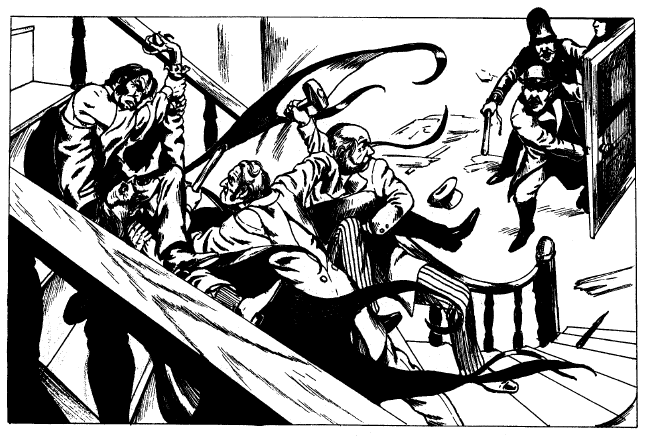
AWFUL WAFFLE! AWFUL WAFFLE!
The campaign book ends with another printing of the Action Table, and apropos of nothing, a SAVE timeline. It's pretty funny, here are some choice bits:
1844: Charles O'Boylan founds SAVE in Dublin, Ireland.
1846: Charles O'Boylan is killed by mummies in Egypt.
1868: SAVE kills its first vampire, recorded as "Vampirus Macedonicus."
1874: SAVE exorcises its first ghost.
1892: SAVE investigates a Welsh mining town wherein 200 miners suddenly disappeared, then everyone in town was either murdered or locked in an asylum for blaming the murders on zombie miners.
1895: A SAVE team including O'Boylan's son go after "the Zombie Master of the Congo."
1912: O'Boylan's team fail to capture the mysterious "she-creature."
1922: O'Boylan goes on another bungled mission in search of the Loch Ness Monster.
1932: A Japanese doctor records the first case of the Unknown in the "Far East," a rotting nocturnal zombie creature that breaks people in half and drinks their blood.
1937: A total badass named Captain Doug Rivers takes his ship on a mission to destroy a pirate ship full of murderous pirate ghosts.
1948: SAVE discovers the proper method for killing a Haitian zombie, using sea salt and a needle-and-thread.
1967: SAVE establishes members in communist-ruled China.
1974: SAVE covertly tries to get permission to look for ghost presidents in the White House. I'm not making this up. The gubmint turns them down.
1978: SAVE gets reports from the Amazon basin about a tribe that shrinks heads and sends the heads to go around biting people. Instead of thinking this is hilarious, they send an investigative team which doesn't return.
Next time, on CHILL : The monster book, the last, best part of the game.
Monsters
Original SA post
CHILL: Horrors from the Unknown
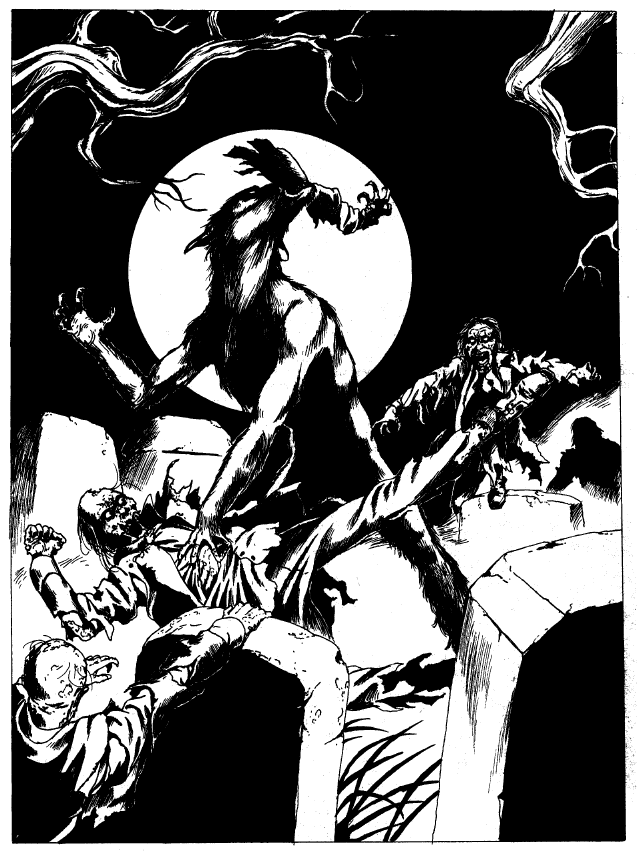
SNAP INTO A SLIM JIM OH YEAH
CHILL makes us wait for the monster stats by including a short piece on normal animals and creature generation rules. Shit! You can randomly generate stats for animals and monsters by taking the Column number they give you for each stat, finding the low range of numbers for that column on the CHILL Action Table TM , and adding 2d10, or you can just take the (about) average numbers in the parentheses. Monsters have some stats that players don’t--Evil Way score, which they use for their powers, the FEAR number for fear checks, ATT to indicate if they get extra attacks, and a note on whether or not they have the necessary prehensile bits to use tools like humans do.
Welcome to the world of Dungeons & Draculas: You get Insight Points (experience) for beating animals and monsters: the full value for destroying them, and half-value for driving them off. Animals’ IP values don’t apply if you just brain a hapless pony.
Bats : Bats will fuck your shit up. They have crappy stats except for Agility, and the only way they can injure you is with a 5% chance of disease if they manage to bite you. However, a bat swooping around overhead can force PCs to make an Agility check to spend the round croucing and ducking instead of their intended actions. They’re also really hard to hit. I know this emulates the “bats in the hair” thing from a bunch of old horror movies, but I don’t think the writers thought about how badly a Dracula can fuck over the whole party with a few action-denying bat minions.
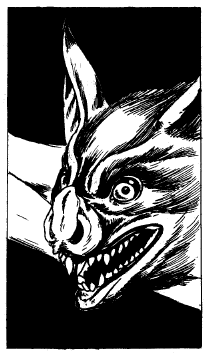
Cats : Individually, they’re mostly harmless--they get two attacks, but with a crappy skill, and can never do more than a light wound. They could be dangerous in packs. Fortunately, CHILL rules don’t suffer from the “cat killing a commoner” problem.
Horses : These fuckers are dangerous. Big, strong, and tough, and they get 2 attacks at 90% to kick and trample, with hooves that are considered weapons. Fortunately, they rarely attack humans, and I don’t think there are any monsters with horse-controlling powers.
Mamba : It can’t inflict much damage, of course, but it has a 60% bite attack that injects Strength 9 poison. That means unless you’re really tough, it’s a choice between “die in seconds” and “die in minutes” unless you get help.
Rat : Rats combine the “dangerous in groups” aspect of cats with the disease-vector ability of bats. And you’re much more likely to have to fight fifty of them at a time. At least they’re easy to kill, but there are no rules for treating a swarm as a group.
Spider : All spiders are assumed to be small enough that their stats are superfluous; all that really matters is if you get bitten by a dangerous one. They have a 23% chance to bite a fully-clothed character, and the venom varies by spider.
Vulture : They don’t usually attack humans, which is fortunate; they’re pretty strong and tough and have a bite attack that’s treated as a weapon, and they have a 10% to give you a disease with their carrion-breath.
Wolves : Traveling in packs of up to 20, wolves don’t normally attack humans, but of course they don’t need to be controlled by a Dracula to do it, either. They get 2 attacks at 60% and their claws are considered weapons, but they can be held at bay by fire.
Okay. onto the actual monsters.
Banshees : Banshees exist to allow CMs to plan an adventure that requires the PCs to do a very specific set of things and is incredibly goddamned annoying. Banshees are incorporeal, and they will come for a specific victim which they attack with their unique Steal Life Force power, which they activate by wailing. This attacks the victim’s Willpower, and while it may only steal some Willpower and leave them shaken, it will probably send them into a deathlike trance.
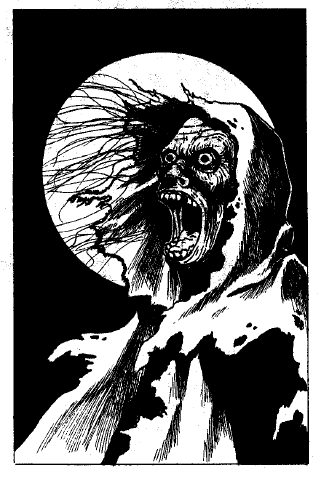
You, when you realize the CM picked this monster for the adventure.
The only way to rescue a banshee victim is for a party (containing at least one of the victim’s friends and carrying at least one possession of the victim) has to find the banshee’s tomb and topple it, which forces the banshee to release the lifeforce. If they knock down the wrong tomb or don’t take a possession along, the banshee might release a different lifeforce into the victim’s body, driving them permanently stark raving mad. The banshee’s only “vulnerabilities” are that nearby inhabitants will suffer depression and nightmares for a week or two leading up to the attack, and the banshee’s wail contains its secret name, which a character with knowledge of ancient languages can learn and use to identify the banshee’s tomb. Note that it doesn’t say anything about the banshee being destroyed when you knock down its tomb. I guess you have to raise it up and knock it down every time it steals someone’s soul.
Changeling : A variety of ghost that wants to steal a physical body for itself. It manifests, strikes a character, and then runs away to its grave, where it soon starts draining Stamina from the character at 1d10 points per day. When the victim’s fully drained, they die, and the changeling emerges as an identical double of the victim with all their stats. The only way to save the victim is to find the changeling’s grave and destroy its growing body, which is vulnerable to any normal attacks.
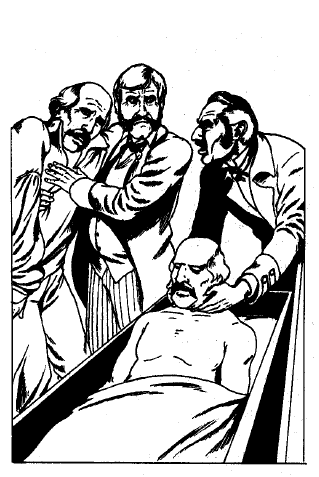
We need to talk about father. Specifically, he's dead.
Fetch : Another incorporeal monster, the fetch is a pearly ball of light that approaches a character and shows them their own face within its swirling interior. This is meant to foretell their death within 24 hours, so you’re supposed to have some potentially fatal attack or accident befall the victim within that time. The fetch doesn’t actually do anything on its own, and you can’t get IPs from them.
Ghost : Ghosts are spirits of dead people--presumably bad ones. They are normally incorporeal and invisible, but can manifest as a foggy or shifting image of a person. They have the potent Terrorize discipline, and attack with a chilling touch, which uses EWS to make a melee attack that can stun for one round. In order to kill them, you either have to destroy a specific object or place associated with them, or else accomplish some goal they left unfinished, so that they can move on.
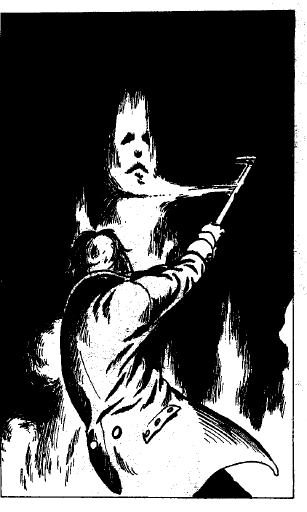
Do not taunt mopey ghost tree.
Ghouls : You really don’t want to have to fight these guys. They have great physical stats, get 3 attacks with their claws, and they have a 15% chance to make you sick. Fortunately, most of them don’t have any disciplines, although they sometimes have powers like Animate Dead, Darken, and Purified Shell. They look like humans when they first enter the Known World, so they can stay undercover for years before they start developing the canine features, bony limbs and grey skin for which they’re known. Worst of all, they can work in packs of as many as 8 ghouls.
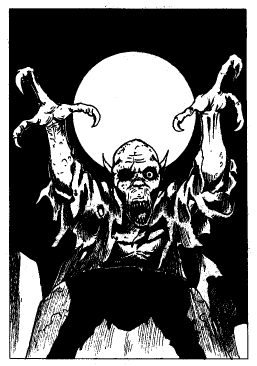
Huuugs!
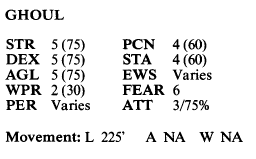
Hate : A variety of ghost, Hates are totally incorporeal and invisible. They’re created when an evil person is murdered, and their sole purpose is to use the Influence power to manipulate a mortal into taking revenge on their killer. You can be rid of them in four ways: One, you can do their bidding and murder the target. Two, you can free yourself from the Influence power using the usual method. Three, you can die, but you become a Hate yourself. Lastly, you can be free from the power of the Hate by selflessly risking your life for someone else. This is the perfect opportunity to run a Stephen King style plot in which only one player can really participate.
Mummy (Common Memphian) : “The common Memphian mummy is the intelligent, undead corpse of a highly-important ancient Egyptian.” Huh, I didn’t know there were enough high-class Egyptian dead people dangling about for there to be a “common mummy.” I hope these bastards aren’t common at all, because they’re scary. They’re clumsy and slow, but they’re strong and tough, get 3 attacks (why?) and their Discipline layout includes Blur Vision, which can blow your entire party’s rolls to hell, and Hound, the power that lets them put a magic GPS tracker on you and then suddenly appear in your house one night. The worst thing about them is how fucking hard they are to kill: they only take Wounds from fire, silver, or water (which burns them like fire), and when you’ve critically wounded them, a whirlwind carries them off to be revived in their tomb, instantly. “SAVE believes” that you can kill a mummy by finding and reading the magic scroll used to create it, which takes two full turns (and the mummy magically appears 1d10 rounds into the reading). I guess SAVE’s never actually managed to destroy a mummy, then. So if you find an ancient Egyptian dig site with a bunch of scrolls, hire a pack of mercenaries armed with silver bullets and read the scrolls as quick as you can. If a guy wrapped in bandages appears, tries to murder you, and crumbles to dust, congratulations, you’ve helped rid the world of the common problem of mummy infestation.
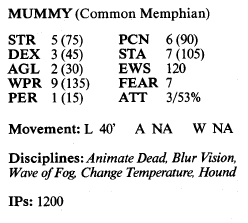
Vampire (Common Carpathian) : Carpathian vampires are said to be the weakest kind of Dracula, as those who survive eventually become something even more dangerous. These run-of-the-mill vampires are bad enough: Superhumanly strong, agile, and tough, attacking twice at 98% with unarmed attacks that hit like weapons.
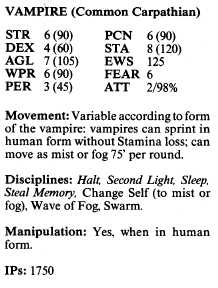
Common vampires’ powerset is, like D&D, of the “everything from every Hammer Horror film thrown in a bucket” type, which makes them very formidable but also kind of annoying to keep track of. They can become impossibly thin to slip through any opening, climb walls like an insect, and transform into mist and fog. They take Stamina loss from attacks, but ignore wounds, and reducing them to 0 STA just means they turn to mist and return to their grave to recuperate in 24 hours. They only try to drain blood from sleeping characters, feeding 1d10 minutes for (minutes)d10 Stamina loss. They usually close the wound and keep the victim alive for awhile, but anyone who dies from blood drain rises as a vampire in 1d10 weeks.
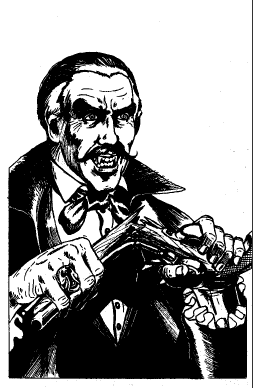
Renfield! Bring more glow-sticks.
As far as weaknesses are concerned, they can’t cross running water on foot, they have to sleep in a bed of earth from their native land without being touched by sunlight, and not only do they have no reflection, mirrors make them violently angry, and they’ll try to smash them. They can be held at bay by garlic, wolfsbane, and crosses.
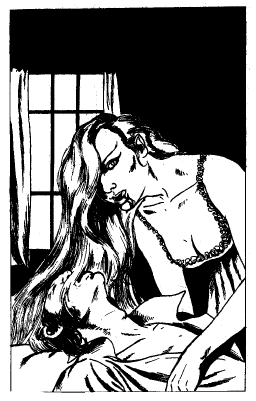
Wasn't she in Clueless ?
You can immobilize a vampire with a stake through the heart, but actually killing them requires a minute of exposure to sunlight, a minute of immersion in running water, or cutting off their head and stuffing the mouth with garlic. I think that makes them kosher.
Werewolves come in three types. Lycanthropes are humans who have been bitten by a werewolf and survived; they transform into a huge wolf during the three nights of the full moon, and each night they must taste human blood before transforming back at dawn.

True werewolves are creatures from the Unknown. They have the same full-moon problem as lycanthropes, but they can also transform back and forth at will. Their wolf-form is also curiously human-looking and has prehensile paws. The loup du mal is a beefed-up form of werewolf that can possess Evil Way disciplines.
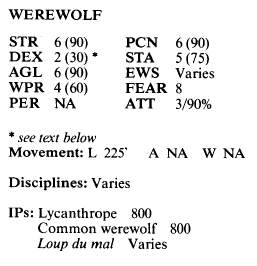
All werewolves have the same great physical stats, 3 attacks (claw/claw/bite) at 90%, and a high FEAR factor. They only take Stamina loss (and not Wounds) from things other than silver bullets, and they regenerate 1d10 Stamina per round in wolf form.
Zombies : Finally, a monster that isn’t a walking thresher. Zombies are strong, but slow and stupid. They always lose Initiative, and their default attack is to use their hands to pummel or strangle, and they’re not very skilled. They can’t use ranged weapons, though their creator can arm them with melee weapons.
There are actually two types of zombies: animated corpses and true zombies. Animated corpses require constant direction to do anything other than attack humans on sight, and if they are torn to pieces, their limbs keep moving and attacking. If reduced to 0 Stamina, they’re down for 1d10 rounds before rising back up at full strength--Killing them requires a “bullet put squarely through the front of [their] forehead.” I don’t know why you can’t shoot them through the back of the head or just brain them with a baseball bat. True zombies don’t have that neat disembodied-limb power, but the only way to kill them for good is to either fill their mouth with salt and sewing their lips shut, or turning them to face a sea or ocean within line-of-sight. I know, crazy voodoo shit. True zombies are also smart enough to travel great distances, perform a single complex task (like stealing a book or murdering someone) and returning to their master, while trying to go unnoticed.
Neither variety is interested in eating you or turning you into a zombie, and they don’t have any powers.
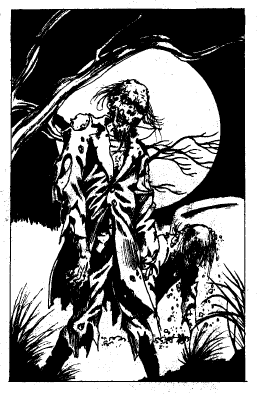
A rejected Iron Maiden cover.
So, those are the monsters of CHILL! I must say, except for the ghoul and the zombie, they’re a big bucket of Fuck You to characters who thought . I know you’re not supposed to just shoot Dracula, but the “common Carpathian” vampire here is a lot tougher than the original Dracula, who just needed a knife in the neck and a stake in the heart to meet his Maker. And a kung-fu mummy who curses your whole party with blindness, gets to instantly run away in a magic whirlwind even if you beat him up, and magically follows you anywhere on earth? I think it has the flute from The Legend of Zelda. Still, there’s a broad assortment of powers, and the rules make it pretty easy to create your own monsters. If I ever review the supplements for the game, I’ve heard there’s a wealth of monsters and variants of existing ones based on more specific cultural mythologies.
Next time, on CHILL : I think at some point in the future I might go through with my original plan of covering all the sourcebooks, including gems like “Vengeance of Dracula” and “Evenings of Terror with Elvira.” How can you not love that? Fuck you.